Grandstream Networks HT802 Analog Telephone Adaptor User Manual
Grandstream Networks, Inc Analog Telephone Adaptor
User Manual
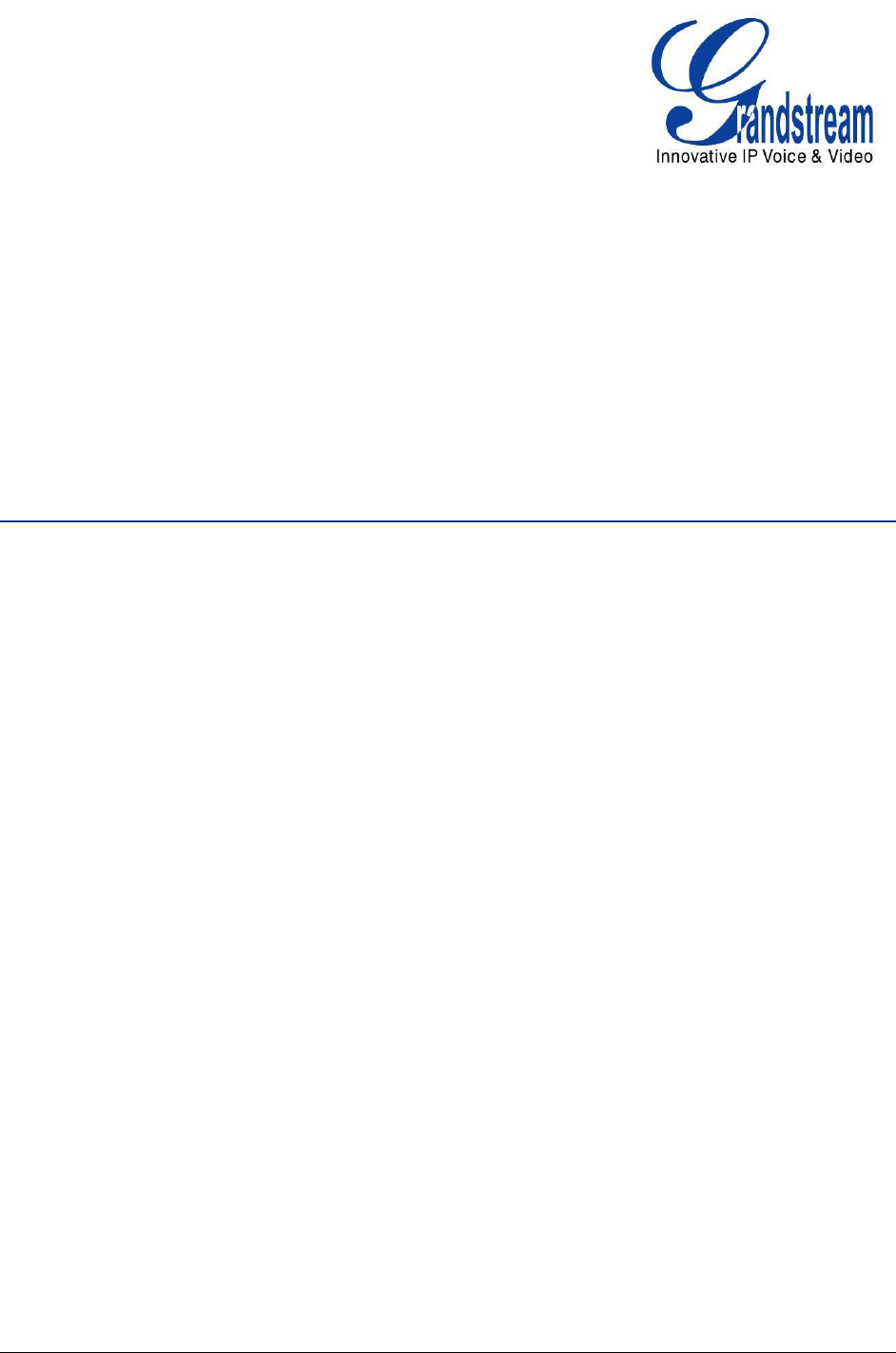
HT80X USER MANUAL
Grandstream Networks, Inc.
HT802 Analog Telephone Adaptor
This page is intentionally left bank

FIRMWARE VERSION 1.0.0.5 HT802 USER MANUAL Page 1 of 46
HT802 USER MANUAL
INDEX
GNU GPL INFORMATION ......................................................................... 4
WELCOME ................................................................................................. 5
SAFETY COMPLIANCES ...................................................................................................................... 5
WARRANTY .......................................................................................................................................... 5
CONNECT YOUR HT802 ........................................................................... 7
EQUIPMENT PACKAGING ................................................................................................................... 7
CONNECTING THE HT802 ................................................................................................................... 7
HT802 FEATRUES ................................................................................... 11
SOFTWARE FEATURES OVERVIEW ................................................................................................ 11
HARDWARE SPECIFICATION ........................................................................................................... 12
BASIC OPERATIONS .............................................................................. 13
UNDERSTANDING HT802 VOICE PROMPT ..................................................................................... 13
PLACING A PHONE CALL .................................................................................................................. 14
Phone or Extension Numbers ....................................................................................................... 14
Direct IP Calls ............................................................................................................................... 15
CALL HOLD ......................................................................................................................................... 16
CALL WAITING .................................................................................................................................... 16
CALL TRANSFER ................................................................................................................................ 16
Blind Transfer ............................................................................................................................... 16
Attended Transfer ......................................................................................................................... 16
3-WAY CONFERENCING ................................................................................................................... 17
FAX SUPPORT .................................................................................................................................... 17
CALL FEATURES .................................................................................... 19
CONFIGURATION GUIDE ....................................................................... 21
CONFIGURING THE HT802 THROUGH VOICE PROMPTS ............................................................. 21
CONFIGURING THE HT802 VIA WEB BROWSER ........................................................................... 21
Access the Web Configuration Menu ........................................................................................... 21
IMPORTANT SETTINGS ..................................................................................................................... 22
NAT Settings ................................................................................................................................. 22
DTMF Methods ............................................................................................................................. 23

FIRMWARE VERSION 1.0.0.5 HT802 USER MANUAL Page 2 of 46
Preferred VOCODER (Codec) ...................................................................................................... 23
SAVING THE CONFIGURATION CHANGES ..................................................................................... 38
REBOOTING THE HT802 FROM REMOTE ....................................................................................... 38
SOFTWARE UPGRADE .......................................................................... 39
FIRMWARE UPGRADE THROUGH TFTP/HTTP/HTTPS .................................................................. 39
INSTRUCTIONS FOR UPLOAD FROM LOCAL DIRECTORY:.......................................................... 40
INSTRUCTIONS FOR LOCAL FIRMWARE UPGRADE USING TFTP SERVER: ............................. 40
CONFIGURATION FILE DOWNLOAD ................................................................................................ 40
FIRMWARE AND CONFIGURATION FILE PREFIX AND POSTFIX ................................................. 41
MANAGING FIRMWARE AND CONFIGURATION FILE DOWNLOAD .............................................. 41
RESTORE FACTORY DEFAULT SETTING ............................................ 43
FACTORY RESET ............................................................................................................................... 43
Reset Button ................................................................................................................................. 43
IVR Command .............................................................................................................................. 43
Reset from web interface (Reset Type) ........................................................................................ 44

FIRMWARE VERSION 1.0.0.5 HT802 USER MANUAL Page 3 of 46
TABLE OF FIGURES
HT802 USER MANUAL
FIGURE 1: DIAGRAM OF HT802 .................................................................................................................... 8
TABLE OF TABLES
HT802 USER MANUAL
TABLE 1: DEFINISIONS OF THE HT802 CONNECTORS ....................................................................................... 9
TABLE 2: BASIC DEFINITIONS OF THE HT802 LEDS PATTERN ............................................................................ 9
TABLE 4: HT802 SOFTWARE FEATURES ......................................................................................................... 11
TABLE 5: HT802 HARDWARE AND TECHNICAL SPECIFICATIONS ....................................................................... 12
TABLE 6: HT802 IVR MENU DEFINITIONS ....................................................................................................... 13
TABLE 7: HT802 CALL FEATURES .................................................................................................................. 19
TABLE 8: BASIC SETTINGS ............................................................................................................................. 23
TABLE 9: STATUS PAGE ................................................................................................................................. 24
TABLE 10: ADVANCED SETTINGS .................................................................................................................... 26
TABLE 11: ACCOUNT SETTINGS ...................................................................................................................... 30
TABLE 12: HT704 FXS PORTS SETTINGS ............................................................................ 错误!未定义书签。
CONFIGURATION GUI INTERFACE EXAMPLES
HT802 USER MANUAL
1. SCREENSHOT OF ADVANCED USER CONFIGURATION PAGE
2. SCREENSHOT OF BASIC SETTINGS CONFIGURATION PAGE
3. SCREENSHOT OF FXS PORT CONFIGURATION
4. SCREENSHOT OF STATUS PAGE
5. SCREENSHOT OF LOGIN PAGE
6. SCREENSHOT OF REBOOT PAGE
7. SCREENSHOT OF REBOOTING PAGE

FIRMWARE VERSION 1.0.0.5 HT802 USER MANUAL Page 4 of 46
GNU GPL INFORMATION
HT802 firmware contains third-party software licensed under the GNU General Public License (GPL).
Grandstream uses software under the specific terms of the GPL. Please see the GNU General Public
License (GPL) for the exact terms and conditions of the license.
Grandstream GNU GPL related source code can be downloaded from Grandstream web site from:
http://www.grandstream.com/support/faq/gnu_gpl .

FIRMWARE VERSION 1.0.0.5 HT802 USER MANUAL Page 5 of 46
WELCOME
Thank you for purchasing Grandstream’s HT802, the affordable, feature rich Analog Telephone Adaptor.
Grandstream HandyTone802 is a new addition to the popular HandyTone ATA product family. It features
the rich audio quality, a broad range of voice codecs, and functionality including one independent SIP
account per FXS port.
This manual will help you learn how to operate and manage your HandyTone70X Analog Telephone
Adaptor and make the best use of its many upgraded features including simple and quick installation, 3-
way conferencing, direct IP-IP Calling, and new provisioning support among other features. This HT802
is very easy to manage and configure, and is specifically designed to be an easy to use and affordable
VoIP solution for both the residential user and the teleworker.
SAFETY COMPLIANCES
The HT802 phone complies with FCC/CE and various safety standards. The HT802 power adaptor is
compliant with UL standard. Only use the universal power adapter provided with the HT802 package.
The manufacturer’s warranty does not cover damages to the phone caused by unsupported power
adaptors.
WARRANTY
If you purchased your HT802 from a reseller, please contact the company where you purchased your
device for replacement, repair or refund. If you purchased the product directly from Grandstream, contact
your Grandstream Sales and Service Representative for a RMA (Return Materials Authorization) number
before you return the product. Grandstream reserves the right to remedy warranty policy without prior
notification.
Caution: Changes or modifications to this product not expressly approved by Grandstream, or operation
of this product in any way other than as detailed by this User Manual, could void your manufacturer
warranty. Please do not use a different power adaptor with the HT802 as it may cause damage to the
products and void the manufacturer warranty.
Reproduction or transmittal of the entire or any part, in any form or by any means, electronic or print, for
any purpose is not permitted without the express written permission of Grandstream Networks, Inc.

FIRMWARE VERSION 1.0.0.5 HT802 USER MANUAL Page 6 of 46
This page is intentionally left bank

FIRMWARE VERSION 1.0.0.5 HT802 USER MANUAL Page 7 of 46
CONNECT YOUR HT802
Connecting the HT802 is easy. Before you begin, please verify the contents of the HT802 package.
EQUIPMENT PACKAGING
The HT802 ATA package contains:
One HT802 Main Case
One Universal Power Adaptor
One Ethernet Cable
One Vertical Stand (Only on HT702 and HT704 Packages)
CONNECTING THE HT802
The HT802 is designed for easy configuration and easy installation. Configure the HT802 following the
directions in the Configuration section of this manual.
1. Insert a standard RJ11 telephone cable into the Phone port and connect the other end of the
telephone cable to a standard touch-tone analog telephone.
2. Insert the Ethernet cable into the Internet or LAN port of the HT802 and connect the other end of
the Ethernet cable to an uplink port (a router or a modem, etc.)
3. Insert the power adapter into the HT802 and connect it to a wall outlet.
The HT802 Analog Telephone Adaptor is an all-in-one VoIP integrated device designed to be a total
solution for networks providing VoIP services. The HT802 VoIP features and functions are available
using a regular analog telephone.
LAN Port
(RJ-45 connector
10/100 Mbps )
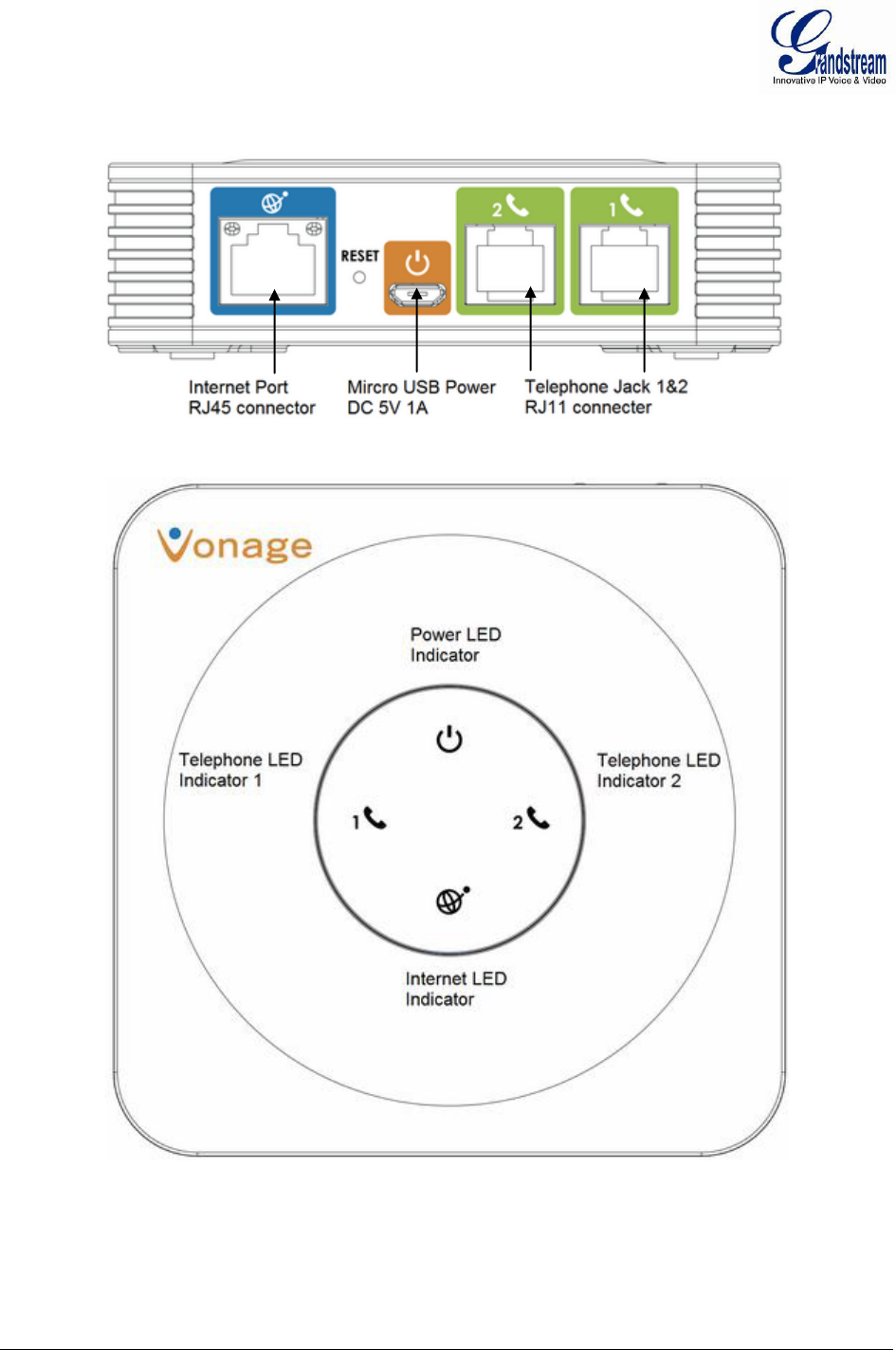
FIRMWARE VERSION 1.0.0.5 HT802 USER MANUAL Page 8 of 46
FIGURE 1: DIAGRAM OF HT802
Reset
Power
Supply
(12V;1A)
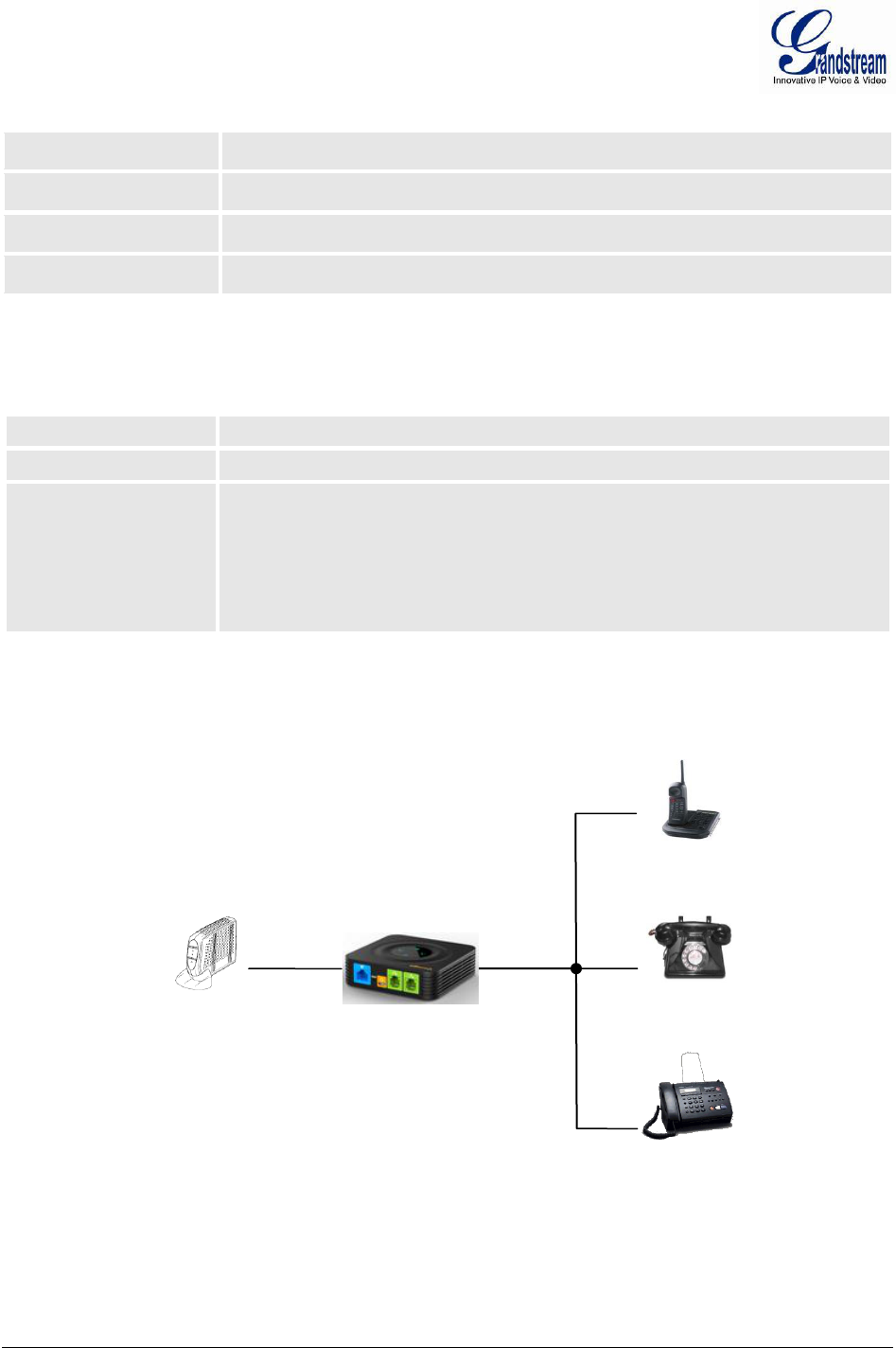
FIRMWARE VERSION 1.0.0.5 HT802 USER MANUAL Page 9 of 46
TABLE 1: DEFINISIONS OF THE HT802 CONNECTORS
Power
Micro USB 5V 1A
Internet Port (RJ-45)
Connect to network.
RESET
Factory Reset button: Press for 7 seconds to reset factory default settings.
Telephone Ports (RJ-11)
Used to connect to analog phones / fax machines.
There are four (4) LED buttons that help you manage the status of your HandyTone 802.
TABLE 2: BASIC DEFINITIONS OF THE HT802 LEDS PATTERN
POWER LED
Indicates Power. Remains ON when power is connected
Internet LED
Indicates Access to Internet. Remains ON while there is Access
PHONE LED 1&2
Indicate status of the respective FXS Ports-PHONE on the back panel
Unregistered – OFF
Registered and Available – ON (Solid Green)
Off-Hook / Busy – Blinking every second
Slow blinking FXS LEDs indicates voicemail
NOTE: All LEDs turns blue when ON
FIGURE 2: HT802 CONNECTION DIAGRAM
Internet
ADSL/Cable
Modem Ethernet
LAN
FXS
Fax
Cordless
Phone
Analog
Phone
HT802

FIRMWARE VERSION 1.0.0.5 HT802 USER MANUAL Page 10 of 46
This page is intentionally left bank

FIRMWARE VERSION 1.0.0.5 HT802 USER MANUAL Page 11 of 46
HT802 FEATRUES
The HT802 is a full feature voice and fax-over IP device that offers a high-level of integration including a
10M/100Mbps network port and one FXS telephone port, market-leading sound quality, rich functionalities,
and a compact and lightweight design. The VoIP network signaling protocol supported is SIP. The HT802
is fully compatible with SIP industry standard and can interoperate with many other SIP compliant devices
and software on the market. Moreover, it supports comprehensive voice codecs including G.711 (a/µ-law),
G.723.1, G.726-32, G.729 and iLBC.
SOFTWARE FEATURES OVERVIEW
Supports Voice Codecs:
G.711 (a/µ-law), G.723.1, G.726-32, G.729 and iLBC.
T.38 Fax
Comprehensive Dial Plan support for Outgoing calls.
G.168 Echo Cancellation
Voice Activation Detection (VAD), Comfort Noise Generation (CNG), and Packet Loss
Concealment (PLC)
Supports PSTN/PBX analog telephone sets
TABLE 3: HT802 SOFTWARE FEATURES
Telephone Interfaces
2 FXS ports
SIP Provisioning
2 Sip Accounts
Number of
Concurrent Calls
2 Concurrent Calls
Voice over Packet
Capabilities
Voice Activity Detection (VAD) with CNG (comfort noise generation) and PLC (packet loss
concealment), Dynamic Jitter Buffer, Modem detection & auto-switch to G.711, Packetized
Voice Protocol Unit (supports RTP/RTCP protocol), G.168 compliant Echo Cancellation,
LEC (line echo cancellation) with NLP, Asymmetric RTP stream
Voice Compression
G.711 + Annex I (PLC), Annex II (VAD/CNG format) encoder and decoder, G.723.1, G.726-
32(ADPCM), G.729, iLBC, G.726-32 provides proprietary VAD, CNG, and signal power
estimation, Voice Play Out unit (reordering, fixed and adaptive jitter buffer, clock
synchronization), AGC (automatic gain control), Status output, Decoder controlling via voice
packet header
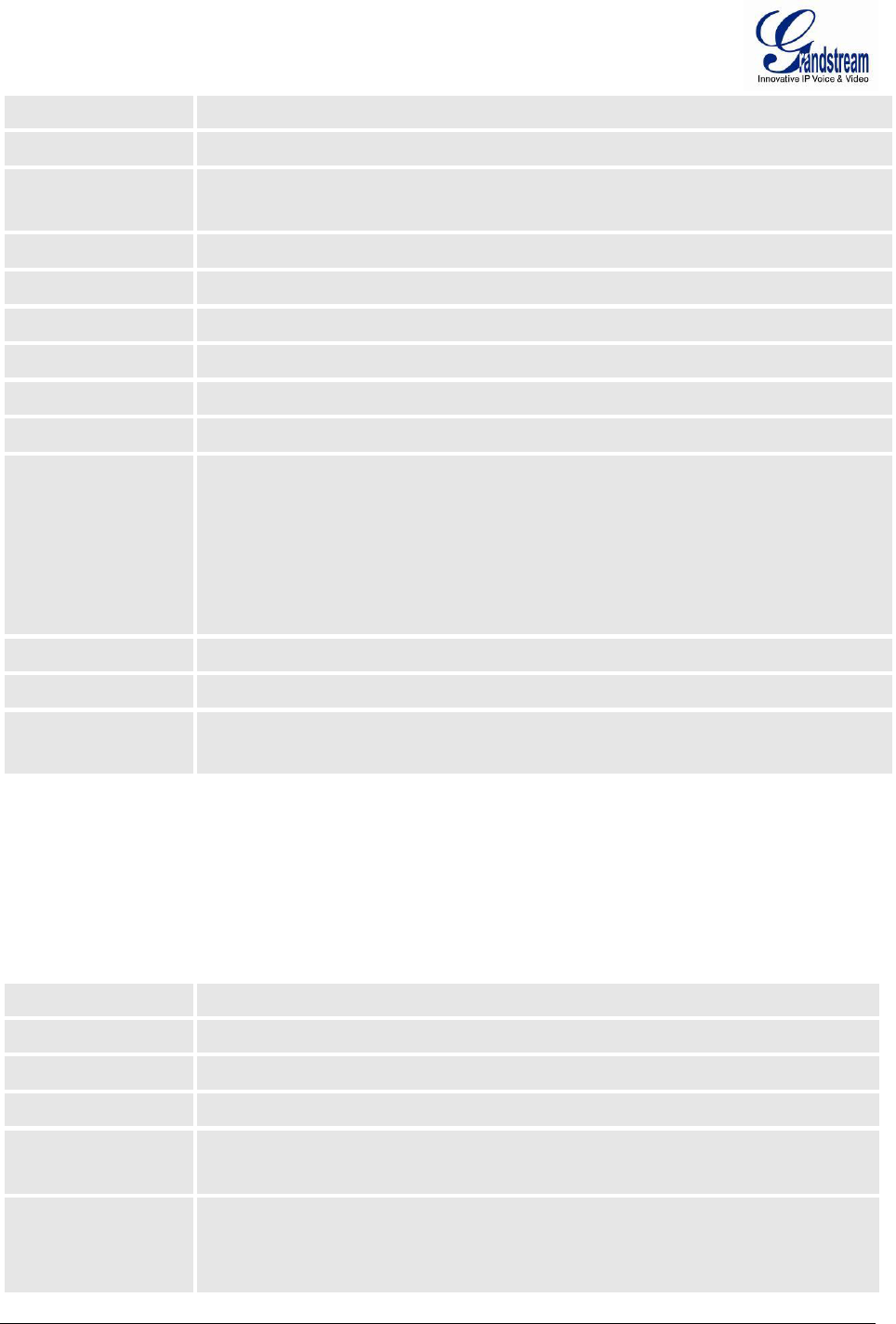
FIRMWARE VERSION 1.0.0.5 HT802 USER MANUAL Page 12 of 46
DHCP Server/Client
Yes, DHCP Client only
Telnet Server
Yes
Fax over Ip
T.38 compliant Group 3 Fax Relay up to 14.4kpbs and auto-switch to G.711 for Fax Pass-
through, Fax Datapump V.17, V.19, V.27ter, V.29 for T.38 fax relay
QoS
Diffserve, TOS, 802.1 P/Q VLAN tagging
Transport Protocol
RTP/RTCP
DTMF Method
Flexible DTMF transmission method, user interface of In-audio, RFC2833, and/or SIP Info
IP Signaling
SIP (RFC 3261)
Provisioning
TFTP, HTTP, HTTPS, TR-069, XML
Control
TLS/SIPS , SIP over TCP/TLS
Device Management
Web interface or via secure encrypted AES or non-encrypted central configuration file for
mass deployment using Grandstream binary file or xml format. Auto/manual provisioning
system or via built-in IVR.
NAT-friendly remote software upgrade (via TFTP/HTTP/HTTPS) for deployed devices
including behind firewall/NAT. Syslog support. Full support of TR-069 management protocol
and Telnet access.
Dial Plan
Yes
Caller ID
Bellcore Type 1 & 2, ETSI, BT, NTT, and DTMF-based CID
Call Handling
Features
Caller ID display or block, Call waiting caller ID, Call waiting/flash, Call transfer, hold,
forward, 3-way conferencing, message waiting, Do-Not-Disturb (DND), call-return service
HARDWARE SPECIFICATION
The table below lists the Hardware and Technical specification of HT802.
TABLE 4: HT802 HARDWARE AND TECHNICAL SPECIFICATIONS
Telephone Interfaces
2 RJ11 FXS port
Network Interface
1 RJ45 10/100 Mb Base-TX, Full Duplex port with connectivity LEDs
LED Indicators
POWER, INTERNET, PHONE1, PHONE2
Factory Reset Button
Yes
Universal Switching
Power Adaptor
Input: AC 100–240 V 50/60 Hz 0.2A max
Output: DC 5V, 1A, UL, FCC certified
Environmental
Operational: 32o–104oF or 0o–40oC
Storage: 14o–140o F or -10 o –60o
Humidity: 10–90% Non-condensing
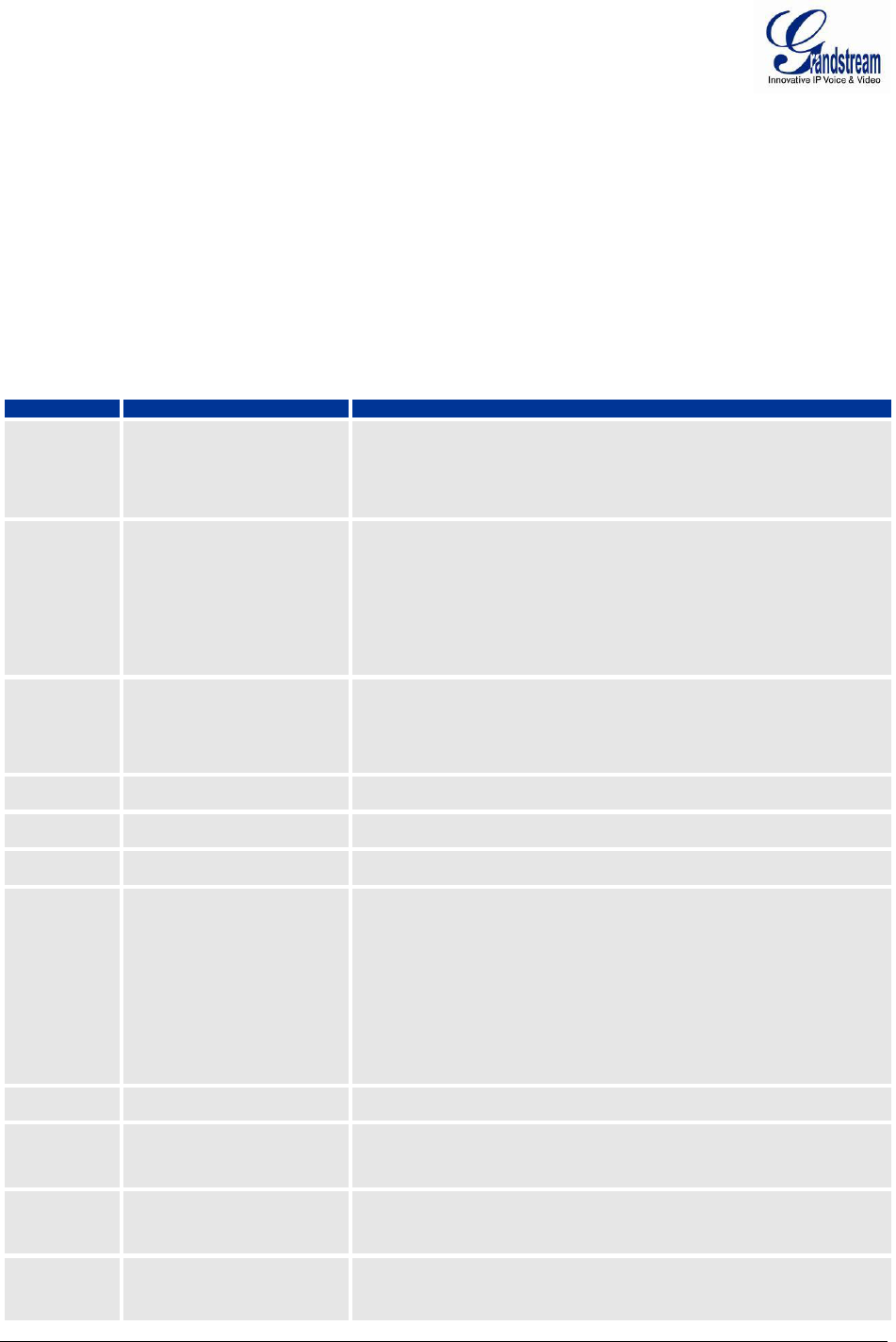
FIRMWARE VERSION 1.0.0.5 HT802 USER MANUAL Page 13 of 46
BASIC OPERATIONS
UNDERSTANDING HT802 VOICE PROMPT
HT802 has a built-in voice prompt menu for simple device configuration. The IVR menu and the LED
button work with any of the FXS port. Pick up the handset and dial “***” to use the IVR menu.
TABLE 5: HT802 IVR MENU DEFINITIONS
MENU
VOICE PROMPT
OPTIONS
Main Menu
“Enter a Menu Option”
Press “*” for the next menu option
Press “#” to return to the main menu
Enter 01-05, 07,10, 13-17,47 or 99 menu options
01
“DHCP Mode”,
“Static IP Mode”
Press “9” to toggle the selection
If using “Static IP Mode”, configure the IP address information using
menus 02 to 05.
If using “Dynamic IP Mode”, all IP address information comes from
the DHCP server automatically after reboot.
02
“IP Address “ + IP address
The current WAN IP address is announced
If using “Static IP Mode”, enter 12 digit new IP address. You need to
reset the HT for the new IP address to take Effect.
03
“Subnet “ + IP address
Same as menu 02
04
“Gateway “ + IP address
Same as menu 02
05
“DNS Server “ + IP address
Same as menu 02
07
Preferred Vocoder
Press “9” to move to the next selection in the list:
PCM U / PCM A
iLBC
G-726
G-723
G-729
10
“MAC Address”
Announces the Mac address of the unit.
13
Firmware Server IP
Address
Announces current Firmware Server IP address. Enter 12 digit new
IP address.
14
Configuration Server IP
Address
Announces current Config Server Path IP address. Enter 12 digit
new IP address.
15
Upgrade Protocol
Upgrade protocol for firmware and configuration update. Press “9” to
toggle between TFTP / HTTP / HTTPS
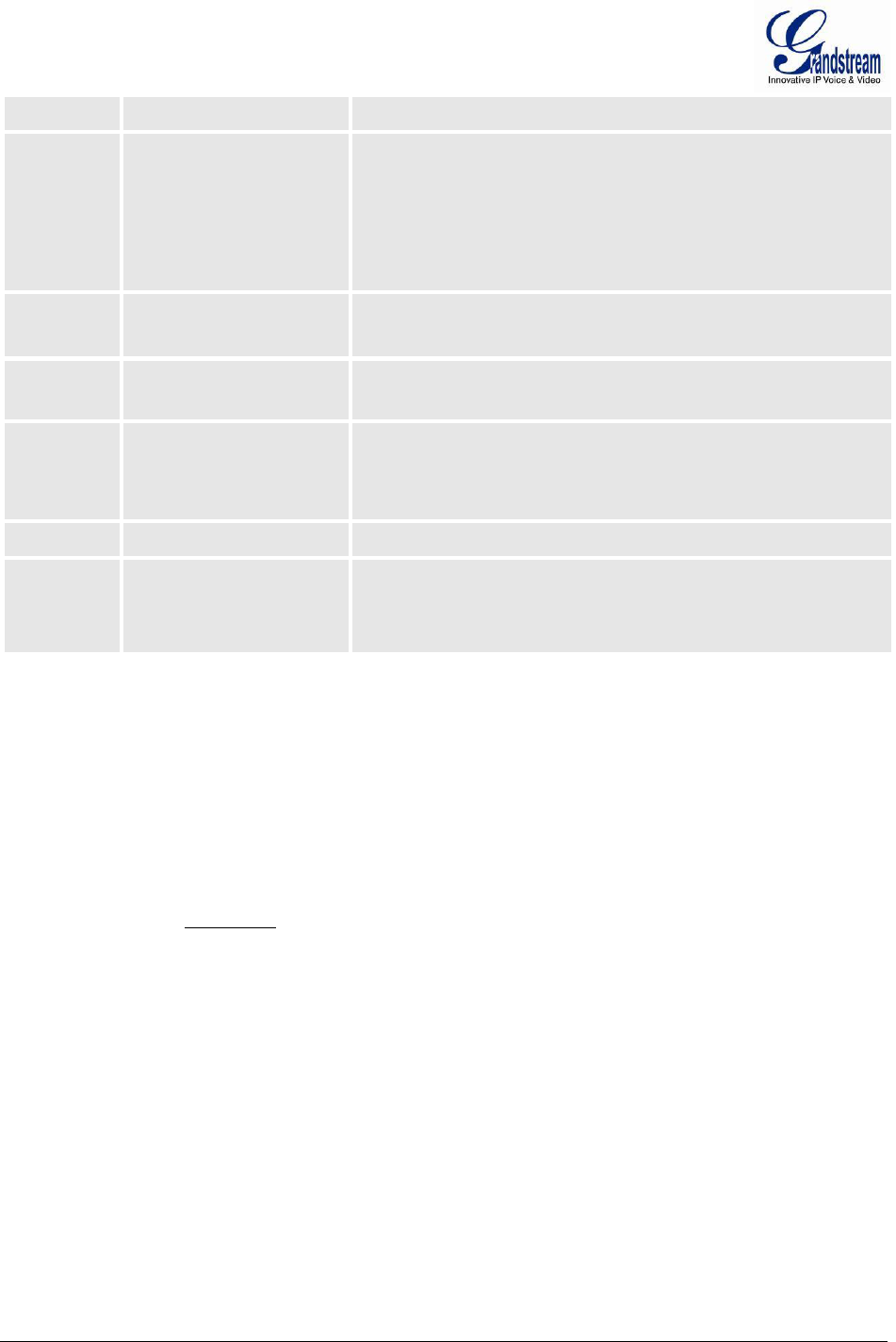
FIRMWARE VERSION 1.0.0.5 HT802 USER MANUAL Page 14 of 46
16
Firmware Version
Firmware version information.
17
Firmware Upgrade
Firmware upgrade mode. Press “9” to toggle among the following
three options:
- always check
- check when pre/suffix changes
- never upgrade
47
“Direct IP Calling”
Enter the target IP address to make a direct IP call, after dial tone.
(See “Make a Direct IP Call”.)
86
Voice Mail
Number of Voice Mails
99
“RESET”
Press “9” to reboot the device
Enter MAC address to restore factory default setting
(See Restore Factory Default Setting section)
“Invalid Entry”
Automatically returns to main menu
“Device not registered”
This prompt will be played immediately after off hook If the device is
not register and the option “Outgoing Call without Registration” is in
NO
Five Success Tips when using the Voice Prompt
1. “*” shifts down to the next menu option
2. “#” returns to the main menu
3. “9” functions as the ENTER key in many cases to confirm or toggle an option
4. All entered digit sequences have known lengths - 2 digits for menu option and 12 digits for IP
address. For IP address, add 0 before the digits if the digits are less than 3 (i.e. - 192.168.0.26
should be key in like 192168000026. No decimal is needed).
5. Key entry cannot be deleted but the phone may prompt error once it is detected
PLACING A PHONE CALL
PHONE OR EXTENSION NUMBERS
1. Dial the number directly and wait for 4 seconds (Default “No Key Entry Timeout”); or
2. Dial the number directly and press # (Use # as dial key” must be configured in web configuration).

FIRMWARE VERSION 1.0.0.5 HT802 USER MANUAL Page 15 of 46
Examples:
1. Dial an extension directly on the same proxy, (e.g. 1008), and then press the # or wait for 4 seconds.
2. Dial an outside number (e.g. (626) 666-7890), first enter the prefix number (usually 1+ or international
code) followed by the phone number. Press # or wait for 4 seconds. Check with your VoIP service
provider for further details on prefix numbers.
DIRECT IP CALLS
Direct IP calling allows two parties, that is, a FXS Port with an analog phone and another VoIP Device, to
talk to each other in an ad hoc fashion without a SIP proxy.
Elements necessary to completing a Direct IP Call:
1. Both HT802 and other VoIP Device, have public IP addresses, or
2. Both HT802 and other VoIP Device are on the same LAN using private IP addresses, or
3. Both HT802 and other VoIP Device can be connected through a router using public or private IP
addresses (with necessary port forwarding or DMZ).
HT802 supports two ways to make Direct IP Calling:
Using IVR
1. Pick up the analog phone then access the voice menu prompt by dial “***”
2. Dial “47” to access the direct IP call menu
3. Enter the IP address after the dial tone and voice prompt “Direct IP Calling”
Using Star Code
1. Pick up the analog phone then dial “*47”
2. Enter the target IP address.
Note: NO dial tone will be played between step 1 and 2.
Destination ports can be specified using “*” (encoding for “:”) followed by the port number.
Examples of Direct IP Calls:
a) If the target IP address is 192.168.0.160, the dialing convention is
*47 or Voice Prompt with option 47, then 192*168*0*160.
followed by pressing the “#” key if it is configured as a send key or wait 4 seconds. In this case,
the default destination port 5060 is used if no port is specified.

FIRMWARE VERSION 1.0.0.5 HT802 USER MANUAL Page 16 of 46
b) If the target IP address/port is 192.168.1.20:5062, then the dialing convention would be:
*47 or Voice Prompt with option 47, then 192*168*0*160*5062 followed by pressing the “#” key
if it is configured as a send key or wait for 4 seconds.
NOTE: When completing direct IP call, the “Use Random SIP/RTP Port” should set to “NO”. You
cannot make direct IP calls between FXS1 to FXS2 since they are using same IP.
CALL HOLD
Place a call on hold by pressing the “flash” button on the analog phone (if the phone has that button).
Press the “flash” button again to release the previously held Caller and resume conversation. If no “flash”
button is available, use “hook flash” (toggle on-off hook quickly). You may drop a call using hook flash.
CALL WAITING
Call waiting tone (3 short beeps) indicates an incoming call, if the call waiting feature is enabled. Toggle
between incoming call and current call by pressing the “flash” button. First call is placed on hold. Press
the “flash” button to toggle between two active calls.
CALL TRANSFER
BLIND TRANSFER
Assume that call Caller A and B are in conversation. A wants to Blind Transfer B to C:
3. Caller A presses FLASH on the analog phone to hear the dial tone.
4. Caller A dials *87 then dials caller C’s number, and then # (or wait for 4 seconds)
5. Caller A will hear the dial tone. Then, A can hang up.
NOTE: “Enable Call Feature” must be set to “Yes” in web configuration page.
ATTENDED TRANSFER
Assume that Caller A and B are in conversation. Caller A wants to Attend Transfer B to C:
1. Caller A presses FLASH on the analog phone for dial tone.
2. Caller A then dials Caller C’s number followed by # (or wait for 4 seconds).
3. If Caller C answers the call, Caller A and Caller C are in conversation. Then A can hang up to
complete transfer.
4. If Caller C does not answer the call, Caller A can press “flash” to resume call with Caller B.

FIRMWARE VERSION 1.0.0.5 HT802 USER MANUAL Page 17 of 46
NOTE: When Attended Transfer fails and A hangs up, the HT802 will ring back user A to remind A that B
is still on the call. A can pick up the phone to resume conversation with B.
3-WAY CONFERENCING
The HT802 supports Bellcore style 3-way Conference.
Instructions for 3-way conference:
Assume that call party A and B are in conversation. Caller A(HT802) wants to bring third Caller C into
conference:
1. A presses FLASH (on the analog phone, or Hook Flash for old model phones) to get a dial tone.
2. A dials C’s number then # (or wait for 4 seconds).
3. If C answers the call, then A presses FLASH to bring B, C in the conference.
4. If C does not answer the call, A can press FLASH back to talk to B.
5. If A presses FLASH during conference, C will be dropped out.
6. If A hangs up, the conference will be terminated for all three parties when configuration “Transfer
on Conference Hang up” is set to “No”. If the configuration is set to “Yes”, A will transfer B to C so
that B and C can continue the conversation.
FAX SUPPORT
HT802 supports FAX in two modes: 1) T.38 (Fax over IP) and 2) fax pass through. T.38 is the preferred
method because it is more reliable and works well in most network conditions. If the service provider
supports T.38, please use this method by selecting Fax mode to be T.38 (default). If the service provider
does not support T.38, pass-through mode can be used.

FIRMWARE VERSION 1.0.0.5 HT802 USER MANUAL Page 18 of 46
This page is intentionally left bank
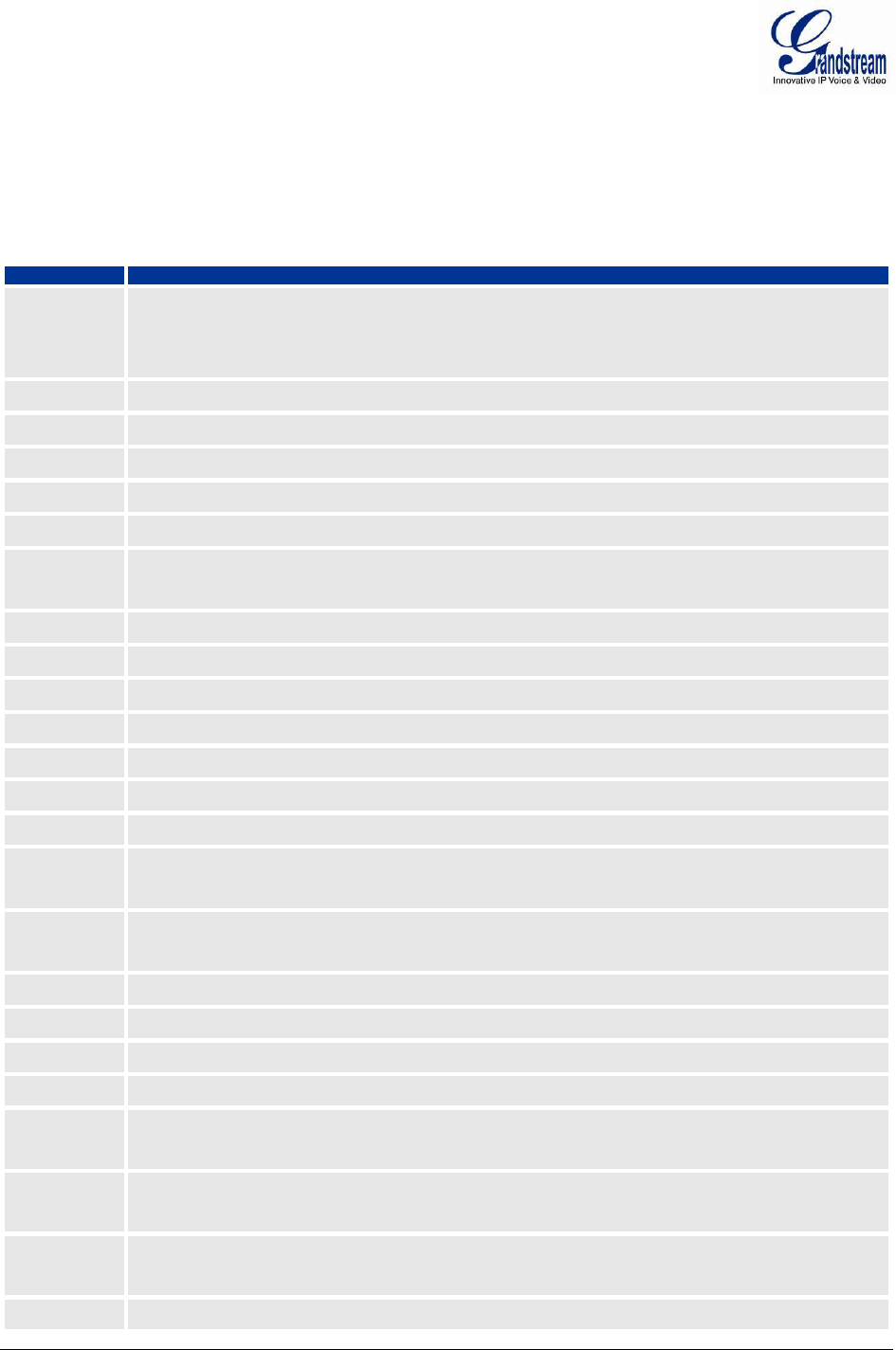
FIRMWARE VERSION 1.0.0.5 HT802 USER MANUAL Page 19 of 46
CALL FEATURES
The HT802 supports all the traditional and advanced telephony features.
TABLE 6: HT802 CALL FEATURES
KEY
CALL FEATURES
*02
Forcing a Codec (per call) *027110 (PCMU), *027111 (PCMA), *02723 (G723), *02729 (G729),
*0272616 (G726-r16), *0272624 (G724-r24), *0272632 (G726-r32), *0272640 (G726-r40),
*027201 (iLBC)
*03
Disable LEC (per call) Dial “*03” + ” number ”. No dial tone is played in the middle.
*16
Enable SRTP
*17
Disable SRTP
*30
Block Caller ID (for all subsequent calls)
*31
Send Caller ID (for all subsequent calls)
*47
Direct IP Calling. Dial “*47” + “IP address”. No dial tone is played in the middle. Detail see Direct
IP Calling section on page 12.
*50
Disable Call Waiting (for all subsequent calls)
*51
Enable Call Waiting (for all subsequent calls)
*67
Block Caller ID (per call). Dial “*67” + ” number ”. No dial tone is played in the middle.
*82
Send Caller ID (per call). Dial “*82” + ” number ”. No dial tone is played in the middle.
*69
Call Return Service: Dial *69 and the phone will dial the last incoming phone number received.
*70
Disable Call Waiting (per call). Dial “*70” + ” number ”. No dial tone is played in the middle.
*71
Enable Call Waiting (per call). Dial “*71” + ” number ”. No dial tone is played in the middle.
*72
Unconditional Call Forward: Dial “*72” and then the forwarding number followed by “#”. Wait for
dial tone and hang up. (dial tone indicates successful forward)
*73
Cancel Unconditional Call Forward. To cancel “Unconditional Call Forward”, dial “*73”, wait for
dial tone, then hang up.
*74
Enable Paging Call: Dial “*74” and then the destination phone number you want to page.
*78
Enable Do Not Disturb (DND): When enabled all incoming calls are rejected.
*79
Disable Do Not Disturb (DND): When disabled, incoming calls are accepted.
*87
Blind Transfer
*90
Busy Call Forward: Dial “*90” and then the forwarding number followed by “#”. Wait for dial tone
then hang up.
*91
Cancel Busy Call Forward. To cancel “Busy Call Forward”, dial “*91”, wait for dial tone, then
hang up.
*92
Delayed Call Forward. Dial “*92” and then the forwarding number followed by “#”. Wait for dial
tone then hang up.
*93
Cancel Delayed Call Forward. To cancel Delayed Call Forward, dial “*93”, wait for dial tone,

FIRMWARE VERSION 1.0.0.5 HT802 USER MANUAL Page 20 of 46
then hang up.
Flash/Hook
Toggles between active call and incoming call (call waiting tone). If not in conversation, flash/hook
will switch to a new channel for a new call.
#
Pressing pound sign will serve as Re-Dial key.

FIRMWARE VERSION 1.0.0.5 HT802 USER MANUAL Page 21 of 46
CONFIGURATION GUIDE
CONFIGURING THE HT802 THROUGH VOICE PROMPTS
DHCP MODE
Select voice menu option 01 to enable HT802 to use DHCP.
STATIC IP MODE
Select voice menu option 01 to enable HT802 to use STATIC IP mode, then use option 02, 03, 04, 05 to
set up IP address, Subnet Mask, Gateway and DNS server respectively.
FIRMWARE SERVER IP ADDRESS
Select voice menu option 13 to configure the IP address of the firmware server.
CONFIGURATION SERVER IP ADDRESS
Select voice menu option 14 to configure the IP address of the configuration server.
UPGRADE PROTOCOL
Select voice menu option 15 to choose firmware and configuration upgrade protocol. User can choose
between TFTP and HTTP.
FIRMWARE UPGRADE MODE
Select voice menu option 17 to choose firmware upgrade mode among the following three options:
1) Always check, 2) check when pre/suffix changes, and 3) never upgrade.
CONFIGURING THE HT802 VIA WEB BROWSER
HT802 has an embedded Web server that will respond to HTTP GET/POST requests. It also has
embedded HTML pages that allow users to configure the HT802 through a web browser such as
Microsoft’s IE, AOL’s Netscape or Mozilla Firefox installed on Windows or Unix OS. (Macintosh OS is not
included).
ACCESS THE WEB CONFIGURATION MENU
1. Find the IP address of the HT802 using voice prompt menu option 02.
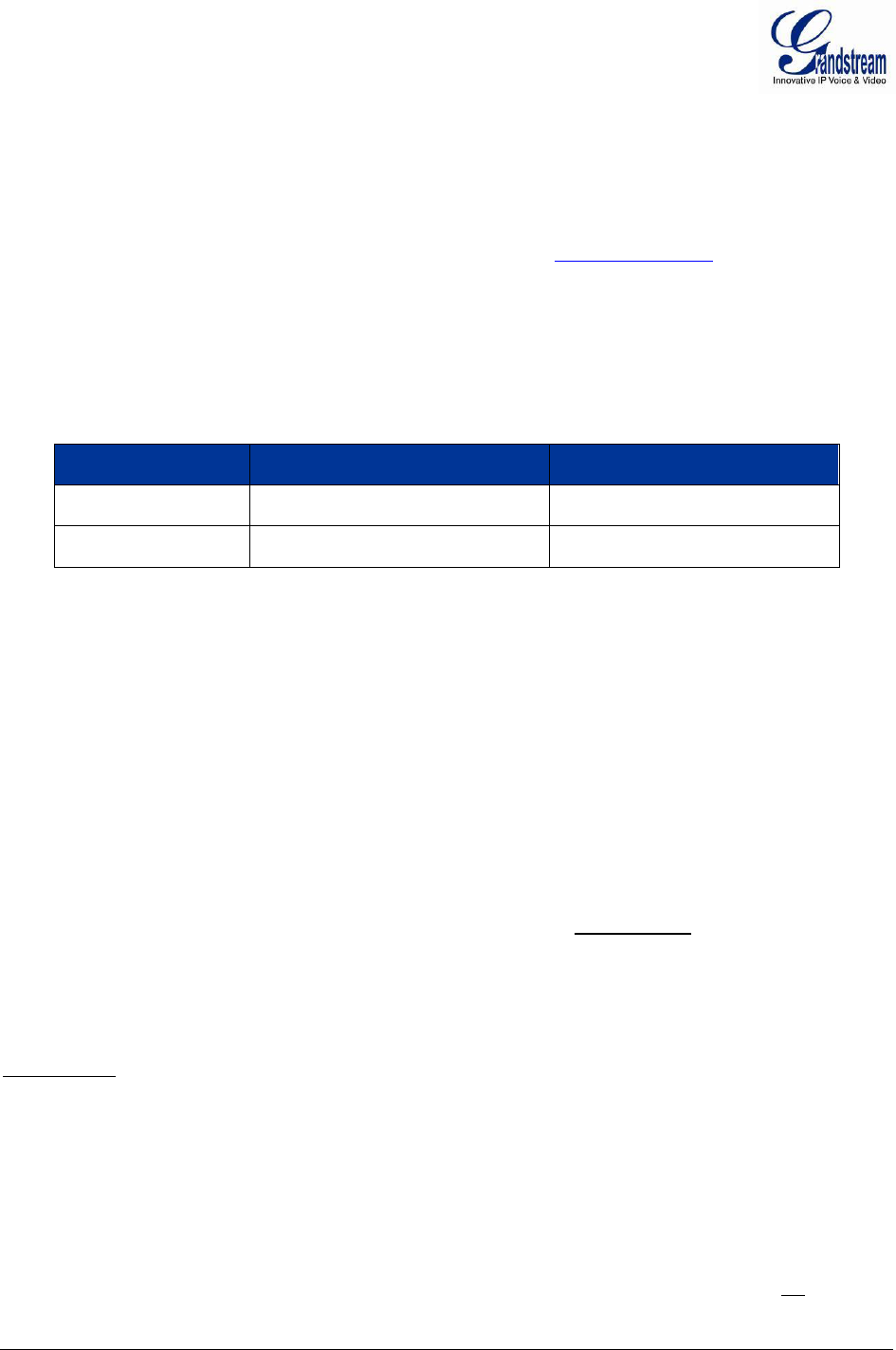
FIRMWARE VERSION 1.0.0.5 HT802 USER MANUAL Page 22 of 46
2. Open a web browser, type the IP address. You will see the log in page of the device.
Note:
• The IVR announces 12 digits IP address, you need to strip out the leading “0” in the IP address.
For ex. IP address: 192.168.001.014, you need to type in http://192.168.1.14 in the web browser.
Once the HTTP request is entered and sent from a web browser, the user will see a log-in screen. There
are two default passwords for the login page:
User Level:
Password:
Web pages allowed:
End User Level
123
Only Status and Basic Settings
Administrator Level
Check with your service provider
Browse all pages
The password is case sensitive with maximum length of 25 characters. The factory default password for
End User and administrator is “123” and “admin” respectively. Only an administrator can access the
“ADVANCED SETTING”, “FXS PORTs” configuration pages.
NOTE: HT802 has factory configuration with random administrator password. Check with your service
provider for more information.
IMPORTANT SETTINGS
The end-user must configure the following settings according to the local environment.
NOTE: Most settings on the web configuration pages are set to the default values.
NAT SETTINGS
If you plan to keep the Handy Tone within a private network behind a firewall, we recommend using
STUN Server. The following three (3) settings are useful in the STUN Server scenario:
1. STUN Server (under Advanced Settings webpage)
Enter a STUN Server IP (or FQDN) that you may have, or look up a free public STUN Server on the
internet and enter it on this field. If using Public IP, keep this field blank.
2. Use Random SIP/RTP Ports (under Advanced Settings webpage)
This setting depends on your network settings. Generally if you have multiple IP devices under the
same network, it should be set to Yes. If using a Public IP address, set this parameter to No.
3. NAT Traversal (under the FXS/Profile web page)

FIRMWARE VERSION 1.0.0.5 HT802 USER MANUAL Page 23 of 46
Set this to Yes when gateway is behind firewall on a private network.
DTMF METHODS
DTMF Settings are in FXS portX/ProfileX page.
DTMF in-audio
DTMF via RTP (RFC2833)
DTMF via SIP INFO
Set priority of DTMF methods according to your preference. This setting should be based on your server
DTMF setting.
PREFERRED VOCODER (CODEC)
The HT802 supports a broad range of voice codecs. Under Profile web pages, choose your preferred
order of different codecs:
PCMU/A (or G711µ/a)
G729 A/B
G723.1
G726 (16/24/32/40)
iLBC
TABLE 7: BASIC SETTINGS
End User Password
Password to access the Web Configuration Menu. This field is case sensitive with a
maximum length of 25 characters.
Web Port
By default, HTTP uses port 80. This field is for customizable web port.
IP Address
There are two modes to operate the HT802:
dynamically assigned via DHCP: all the field values for the Static IP mode are not used
(even though they are still saved in the Flash memory.) The HT802 acquires its IP
address from the first DHCP server it discovers from the LAN it is connected.
Statically configured as: configure the IP address, Subnet Mask, Default Router IP
address.
DHCP hostname
Default is blank. This option specifies the name of the client. This field is optional but may
be required by some Internet Service Providers.

FIRMWARE VERSION 1.0.0.5 HT802 USER MANUAL Page 24 of 46
DHCP vendor class ID
Default is HT7XX. Used by clients and servers to exchange vendor-specific information..
Time Zone
Controls how the date/time is displayed according to the specified time zone.
Self-Defined Time Zone
The syntax is std offset dst [offset],start[/time],end[/time]
Default is set to : MTZ+6MDT+5,M3.2.0,M11.1.0
MTZ+6MDT+5,
Time zone with 6 hours offset with 1 hour ahead which is the US central time. It is positive
(+) if the local time zone is west of the Prime Meridian and negative (-) if it is east.
Prime Meridian (a.k.a: International or Greenwich Meridian)
M3.2.0,M11.1.0
The 1st number indicates Month: 1,2,3,..,12 (for Jan, Feb, .., Dec)
The 2nd number indicates the nth iteration of the weekday: (1st Sunday, 3rd Tuesday etc)
The 3rd number indicates Weekday: 0,1, 2, ..,6(for Sun, Mon, Tue, .., Sat)
Therefore, this example is the DST which starts from the second Sunday of March to the
1st Sunday of November.
Allow DHCP server to
set Time Zone
Default Yes. Let the DHCP server handle the Time Zone
Language
Languages supported with voice prompt and web interface, except Spanish that it is only
in IVR.
Reset Type
Gives the user the option to set to default all VoIP related configuration (mainly everything
located on FXS/Profile page), all ISP (Internet Service Provider) configuration which may
affect the IP address, or both at the same time.
Note: After you choose the reset type, you will have to click the reset button for it to take
effect.
In addition to the Basic Settings configuration page, end users also have access to the Device Status
page.
TABLE 8: STATUS PAGE
MAC Address
The device ID, in HEX format. This is very important ID for ISP troubleshooting. The Mac
address will appear in this place. The MAC address will be used for provisioning and can
be found on the label coming with original box and on the label located on the bottom
panel of the device.
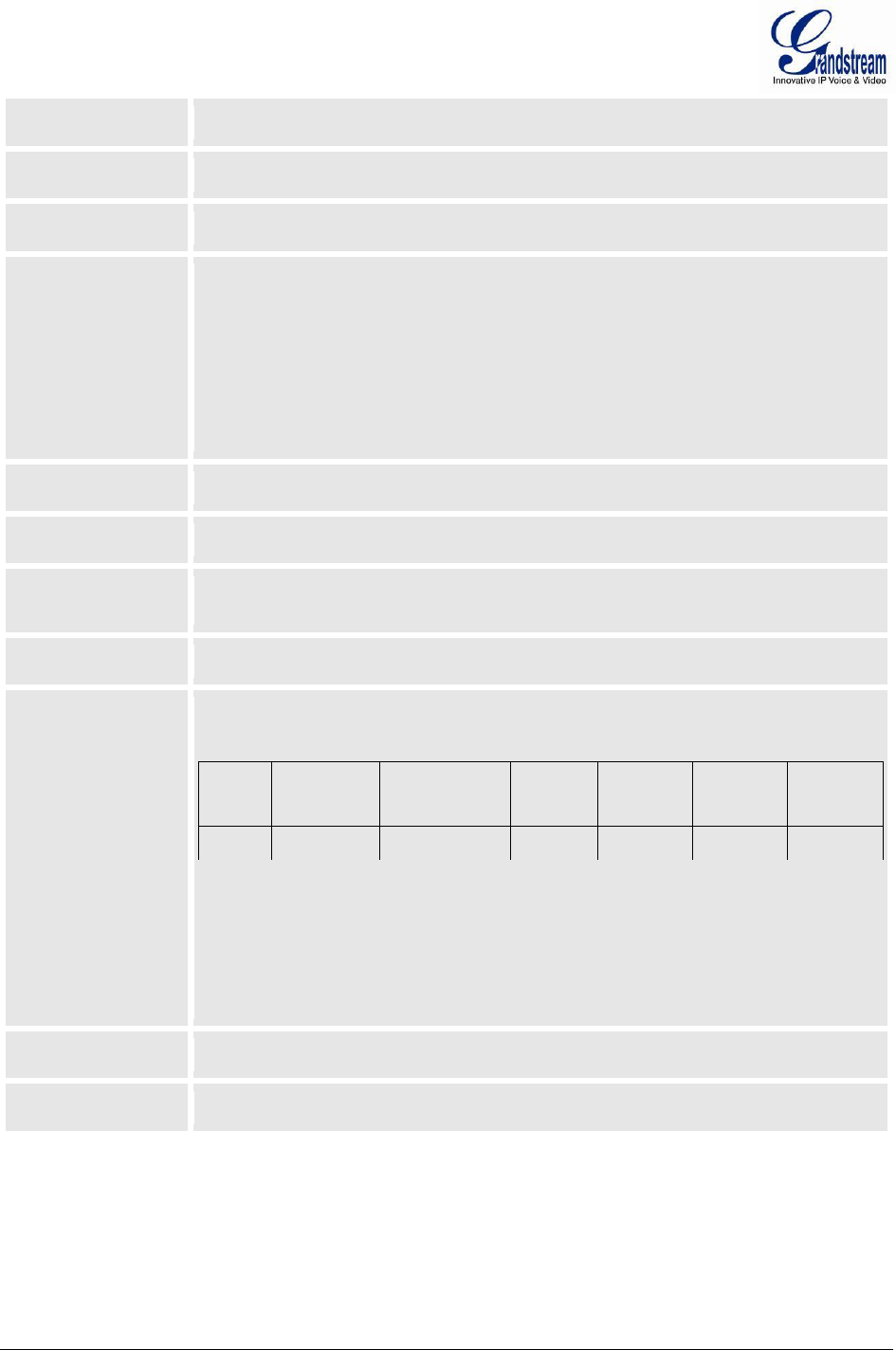
FIRMWARE VERSION 1.0.0.5 HT802 USER MANUAL Page 25 of 46
IP Address
This field shows the IP address of the HT802.
Product Model
This field contains the product model info.
Hardware Version
This field shows the hardware revision of the unit and the part number.
Software Version
Program: This is the main software release. This number is always used for firmware
upgrade. Current release is 1.0.3.1. Boot and Loader are seldom changed.
Bootloader: current version is 1.0.0.7.
Core: current version 1.0.3.1.
Base: current version is 1.0.3.1.
CPE: gs_cpe version number information.
Software Status
Shows software running status and memory status.
System Up Time
Shows system up time since the last reboot.
PPPoE Link Up
Indicates whether the PPPoE connection is up if the HT802 is connected to DSL modem.
NAT
This filed indicates the type of NAT connection used by the HT802.
Port Status
Displays relevant information regarding the FXS port.
Port
Hook
Registration
DND
Forward
Busy
Forward
Delayed
Forward
FXS
On Hook
Registered
Yes
613
• FXS port is registered with SIP Server.
• FXS Port user has set Do Not Disturb.
• FXS Port user has set his calls to be unconditionally forwarded to ext 613.
• FXS Port user has not set Busy or Delay call Forward.
Core Dump
Shows core dump if generated.
Provision
Keeps updating provisioning status
Log in to the advanced user configuration page the same way as for the basic configuration page. The
password is case sensitive and the factory default password for Advanced User is “admin”.
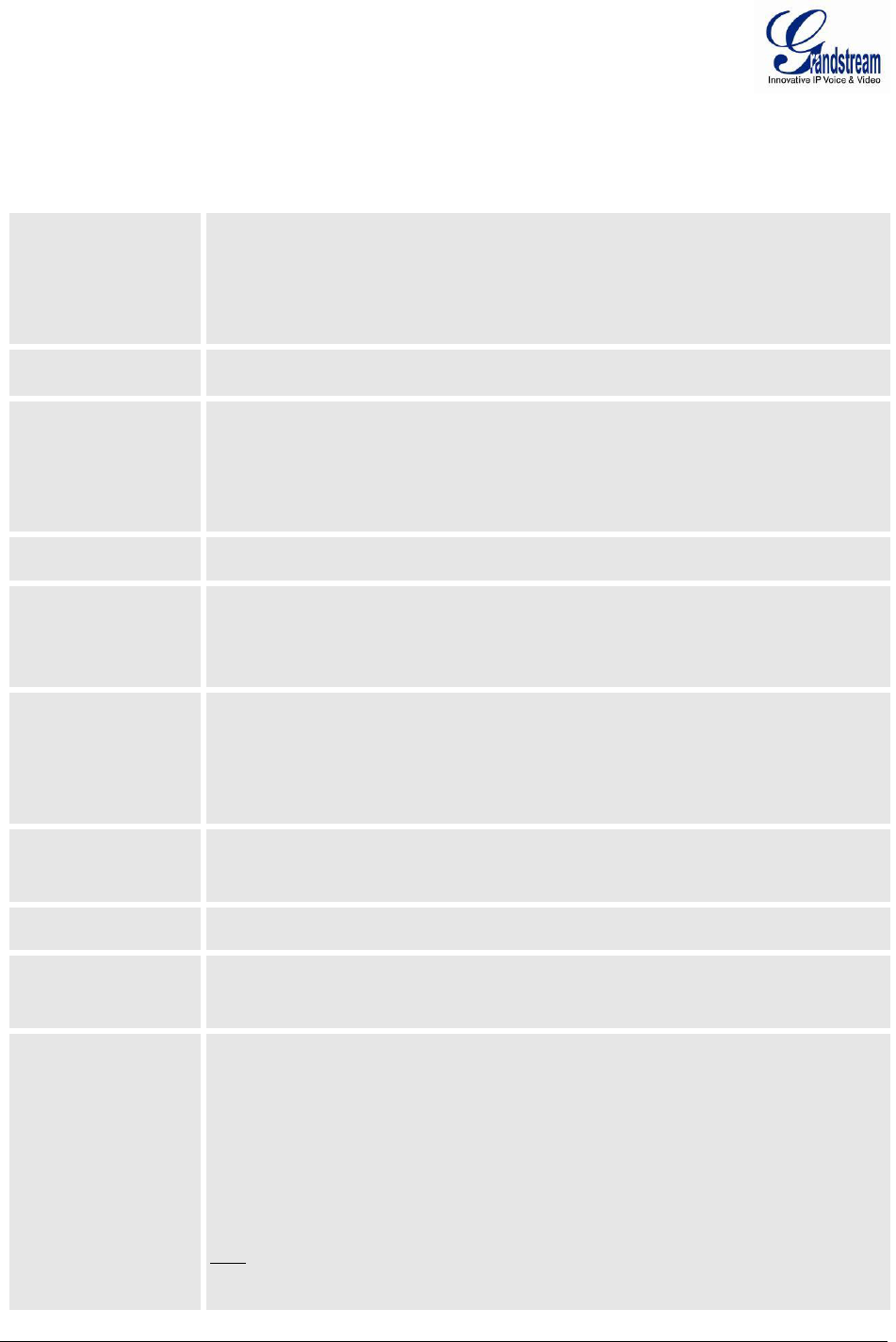
FIRMWARE VERSION 1.0.0.5 HT802 USER MANUAL Page 26 of 46
Advanced User configuration includes the end user configuration and the advanced configurations
including: a) SIP configuration, b) Codec selection, c) NAT Traversal Setting and d) other miscellaneous
configuration.
TABLE 9: ADVANCED SETTINGS
Admin Password
This contains the password to access the Advanced Web Configuration page. This field is
case sensitive. Only the administrator can configure the “Advanced Settings” page.
Password field is purposely left blank for security reasons after clicking update and saved.
The maximum password length is 25 characters.
Layer 3 QoS
Set values for Diff-Serv or Precedence value for both SIP and RTP
Layer 2 QoS
Set values for
802.1Q/VLAN Tag (0-4094)
802.1p priority value (0-7)
802.1p priority value (NATed traffic) (0-7)
STUN Server is
IP address or Domain name of the STUN server.
Keep-alive interval
This parameter specifies how often the HT802 sends a blank UDP packet to the SIP
server in order to keep the “hole” on the NAT open. Default is 20 seconds. Minimum
value is 20 seconds.
Use STUN to detect
network connectivity
Use STUN keep-alive to detect WAN side network problems. If keep-alive request does
not yield any response for configured number of times, the device will restart the TCP/IP
stack. If the STUN server does not respond when the device boots up, the feature is
disabled. Default setting is No.
Use DNS to detect
network connectivity
Use DNS to detect WAN side network problems. Default setting is Yes.
Telnet Server
Enable/Disable telnet server on device.
Firmware Upgrade
and Provisioning
Enables HT802 to download firmware or configuration file through either the TFTP, HTTP
or HTTPS server.
Via TFTP Server
This is the IP address of the configured TFTP server. If selected and it is non-zero or not
blank, the HT802 retrieves the new configuration file or new code image from the
specified TFTP server at boot time. After 5 attempts, the system will timeout and will start
the boot process using the existing code image in the Flash memory. If a TFTP server is
configured and a new code image is retrieved, the new downloaded image is saved into
the Flash memory.
Note: Please do NOT interrupt the TFTP upgrade process (especially the power supply)
as this will damage the device. Depending on the local network, this process can take up
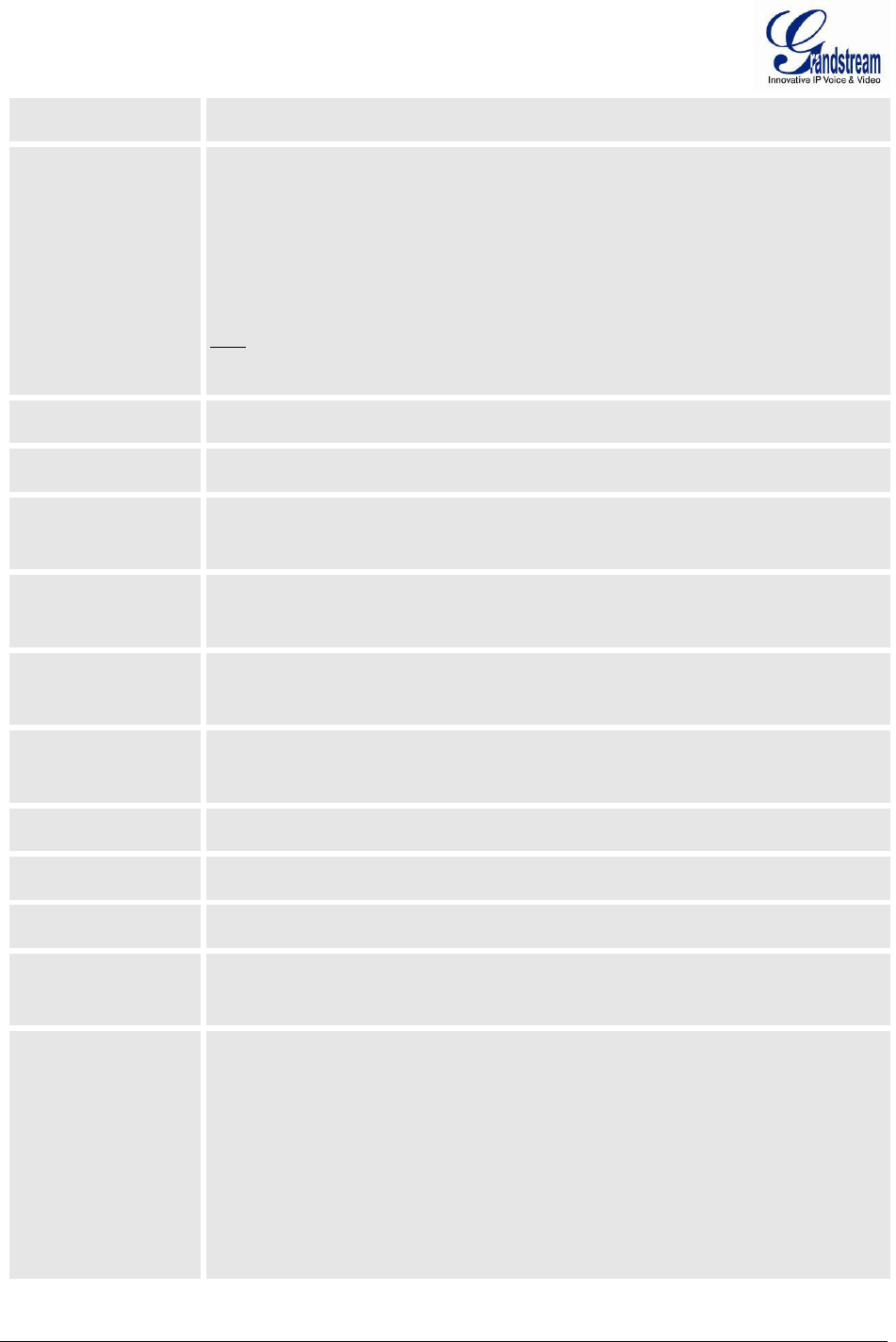
FIRMWARE VERSION 1.0.0.5 HT802 USER MANUAL Page 27 of 46
to 15 or 20 minutes.
Via HTTP / HTTPS
Server
The URL for the HTTP/HTTPS server used for firmware upgrade and configuration via
HTTP.
For example, http://provisioning.mycompany.com:6688/Grandstream/1.0.0.67“:6688” is
the specific TCP port where the HTTP or HTTPS server is listening; it can be omitted if
using default port 80.
Note: If Auto Upgrade is set to No, HT802 will only do HTTP/HTTPS download once at
boot up.
Firmware Server Path
IP address or domain name of firmware server.
Config Server Path
IP address or domain name of configuration server.
XML Config File
Password
The password used for encrypting the XML configuration file using OpenSSL.
This is required for the phone to decrypt the encrypted XML configuration file.
HTTP/HTTPS User
Name
The user name needed to authenticate with the HTTP/HTTPS server.
HTTP/HTTPS
Password
The password needed to authenticate with the HTTP/HTTPS server.
Firmware File Prefix
Default is blank. If configured, HT802 will request firmware file with the prefix. This
setting is useful for ITSPs. End user should keep it blank.
Firmware File Postfix
Default is blank. End user should keep it blank.
Config File Prefix
Default is blank. End user should keep it blank.
Config File Postfix
Default is blank. End user should keep it blank.
Allow DHCP Option 66
to override server
If set to “Yes”, configuration and upgrade server information can be obtained using DHCP
option 66 from DHCP server located in customer’s environment. Default setting is Yes.
Automatic Upgrade
Choose “Yes” to enable automatic upgrade and provisioning. If select “Check every
minutes” input the amount of minutes you want it to check for update. If select “Yes, daily
at hour” make sure to input the hour of the day you want it to check for update, e.g. for 11
pm type 23. If select “Yes, weekly on day” make sure you input the day of the week (in
format 0-6, 0 is Sunday) you want it to check for update. When set to No, HT802 will only
do the following option you select; “Always check for New Firmware at Boot up” will check
for new firmware every time the device reboots. “Check New Firmware only when F/W
pre/suffix changes” will check for updates only when the pre/suffix has been changed.
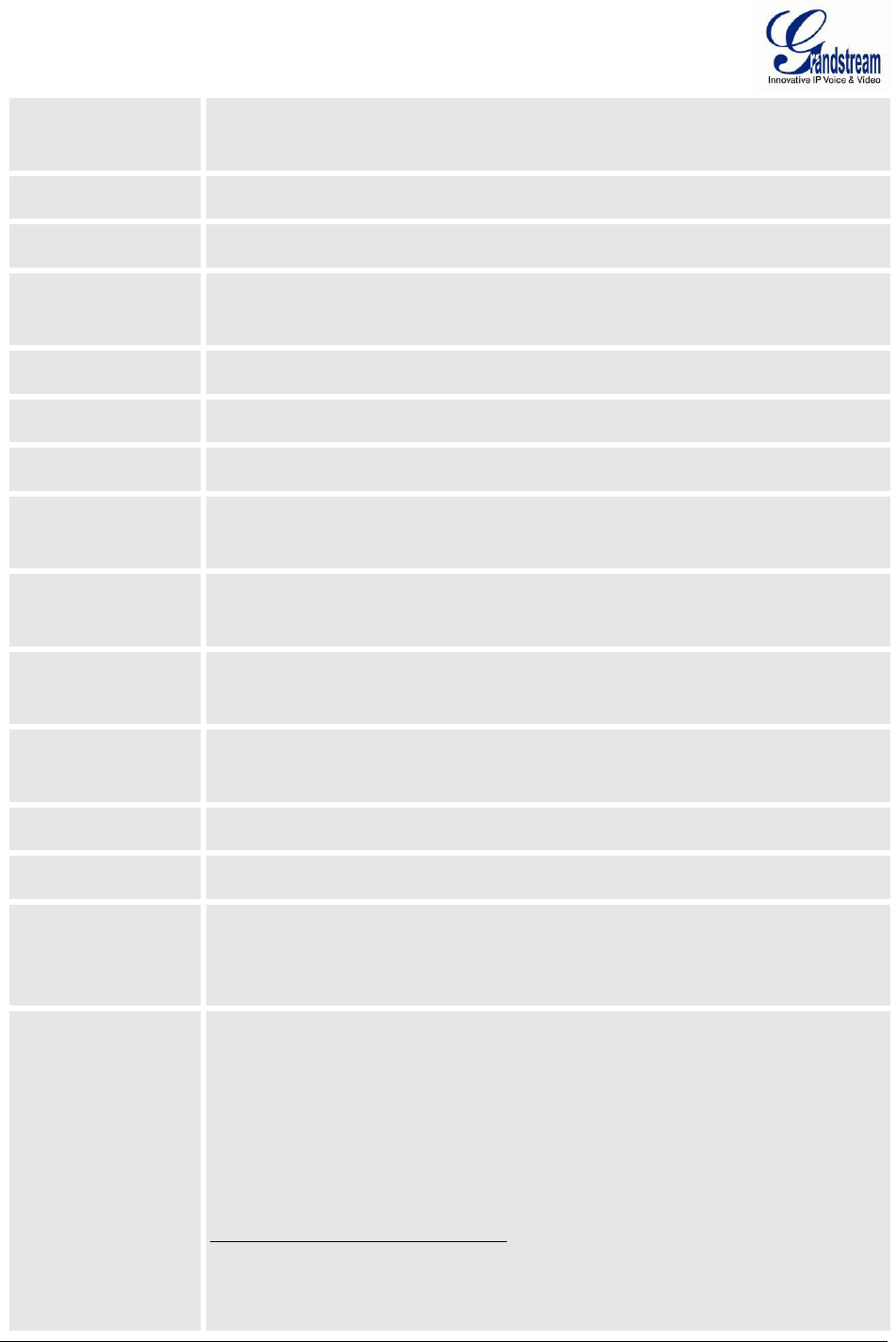
FIRMWARE VERSION 1.0.0.5 HT802 USER MANUAL Page 28 of 46
Authenticate Conf File
If set to Yes, config file is authenticated before acceptance. This protects the
configuration from an unauthorized change.
SIP TLS Certificate
The user specify SSL certificate used for SIP over TLS in X.509 format.
SIP TLS Private Key
The user specify SSL private key used for SIP over TLS in X.509 format.
SIP TLS Private Key
Password
User specify password to protect the private key above.
ACS URL
User specify the Auto Configuration Server’s URL (TR-069 protocol)
ACS Username
User specify the ACS Username
ACS Password
User specify the ACS password
Periodic Inform
Enable
Default is No. If set to YES, device will send inform packets to the ACS
Periodic Inform
Interval
Frequency that the inform packets will be sent out to the ACS
Connection Request
Username
Set a user name for the ACS to connect to this device
Connection Request
Password
Set a password for the ACS to connect to this device
CPE SSL Certificate
The Cert File for the phone to connect to the ACS via SSL.
CPE SSL Private Key
The Cert Key for the phone to connect to the ACS via SSL.
System Ring Cadence
Configuration option is set ring cadence on all FXS ports for all incoming calls. (Syntax:
c=on1/off1-on2/off2-on3/off3(only 3 cadences maximum)) Default is set to c=2000/4000;
(US standards)
Call Progress Tones
Using these settings, users can configure tone frequencies and cadence according to
their preference. By default they are set to North American frequencies. Configure these
settings with known values to avoid uncomfortable high pitch sounds. ON is the period of
ringing (“On time” in ‘ms’) while OFF is the period of silence. In order to set a continuous
tone, OFF should be zero. Otherwise it will ring ON ms and a pause of OFF ms and then
repeat the pattern.
Example configuration for N.A. Dialtone:
f1=350@-13,f2=440@-13,c=0/0;
Syntax: f1=freq@vol, f2=freq@vol, c=on1/off1-on2/off2-on3/off3; [...]
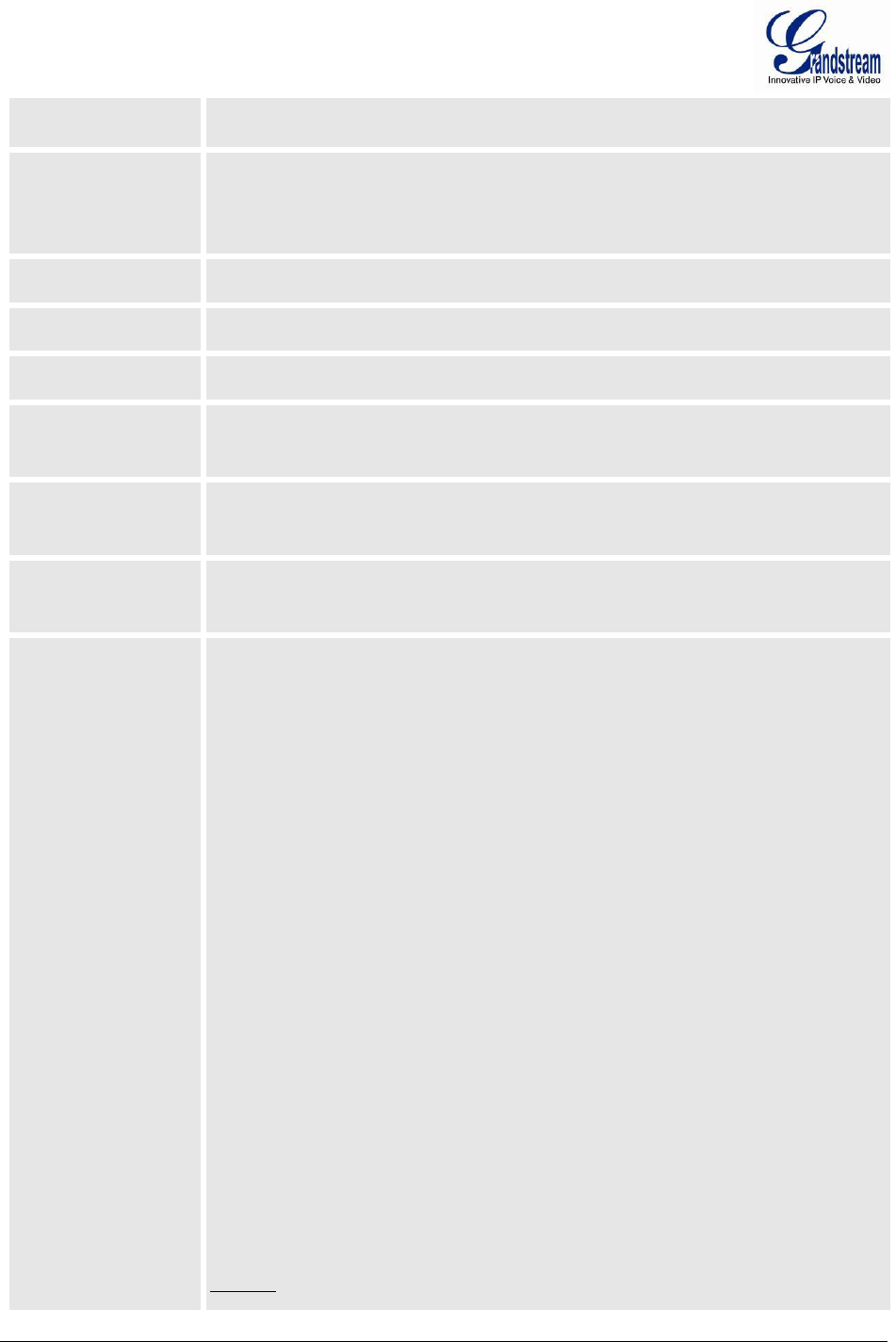
FIRMWARE VERSION 1.0.0.5 HT802 USER MANUAL Page 29 of 46
(Note: freq: 0 - 4000Hz; vol: -30 - 0dBm)
Feature Activation
Codes (* or # followed
by 1-5 digits)
Blind Transfer Code: Custom the Blind Transfer Code (Default #90).
Lock Keypad Update
Default is No. If set to “Yes”, the configuration update via keypad is disabled.
Disable Voice Prompt
Default is No. Disables the voice prompt configuration.
Disable Direct IP Call
Default is No. Disables the Direct IP Call function.
NTP server
URI or IP address of the NTP (Network Time Protocol) server. This parameter
synchronizes the date and time.
Allow DHCP option 42
to override NTP serve
Default Yes. Enables the DHCP server to handle the NTP Server via Option 42
Syslog Server
The IP address or URL of System log server. This feature is especially useful for the ITSP
(Internet Telephone Service Provider)
Syslog Level
Select the HT802 to report the log level. Default is NONE. The level is one of EXTRA
DEBUG, DEBUG, INFO, WARNING or ERROR. Syslog messages are sent based on the
following events:
1. product model/version on boot up (INFO level)
2. NAT related info (INFO level)
3. sent or received SIP message (DEBUG level)
4. SIP message summary (INFO level)
5. inbound and outbound calls (INFO level)
6. registration status change (INFO level)
7. negotiated codec (INFO level)
8. Ethernet link up (INFO level)
9. SLIC chip exception (WARNING and ERROR levels)
10. memory exception (ERROR level)
11. Vonage requested syslog style (EXTRA DEBUG level)
The Syslog uses USER facility. In addition to standard Syslog payload, it contains the
following components:
GS_LOG: [device MAC address][error code] error message
Example: May 19 02:40:38 192.168.1.14 GS_LOG: [00:0b:82:00:a1:be][000] Ethernet link
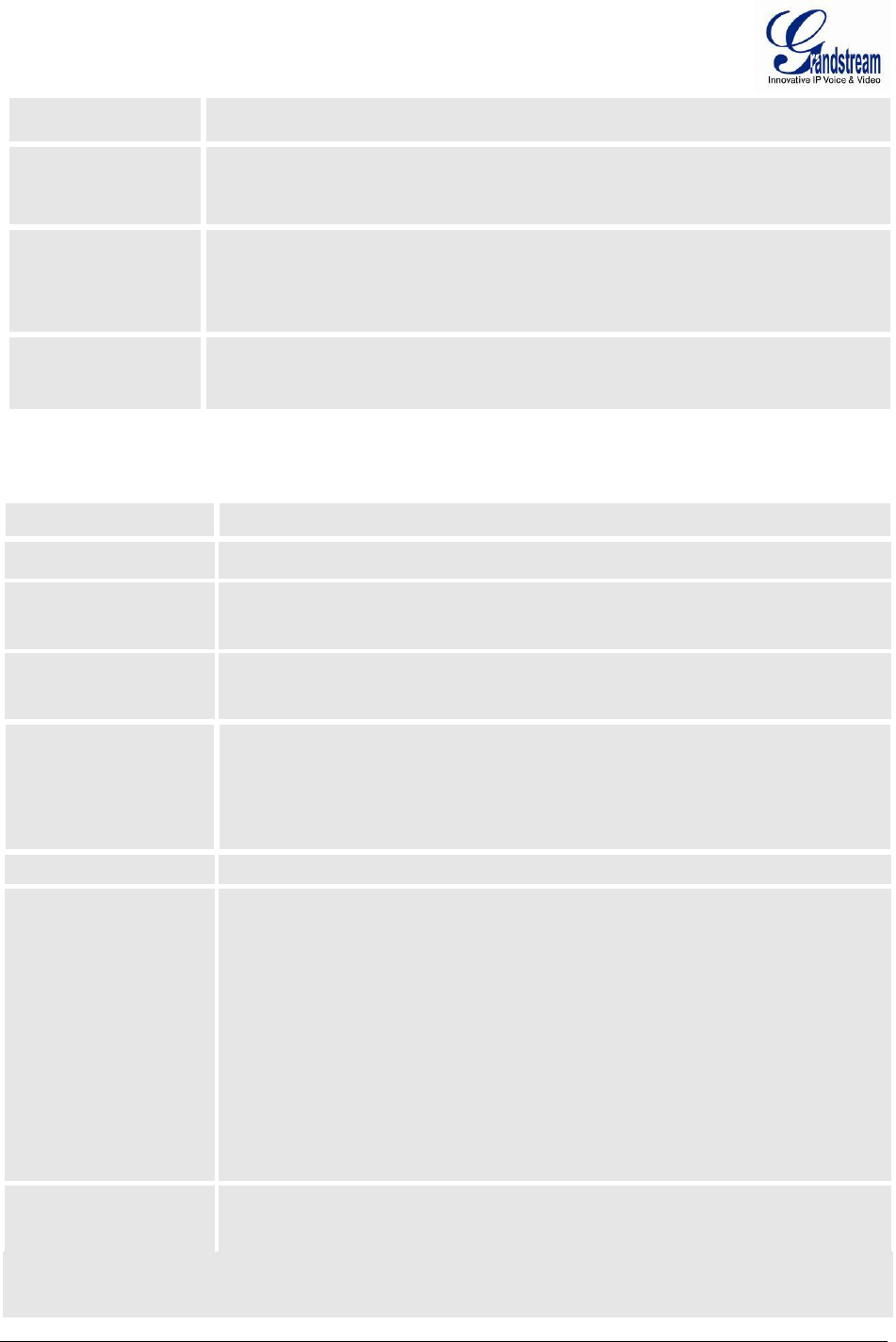
FIRMWARE VERSION 1.0.0.5 HT802 USER MANUAL Page 30 of 46
is up
Send SIP Log
Default is No. If Enabled, the HT802 will send a replicate of the SIP packets on the
syslog.
Download Device
Configuration
Allows user to download and save a text file containing all the P values of each setting as
configured at that point on the unit. (Note: For Security Reasons, all Passwords won’t be
Downloaded)
Upload Firmware
Allows the user to upgrade the firmware with a single firmware file by browsing and
loading the file from your computer (local directory).
TABLE 10: ACCOUNT SETTINGS
Account Active
When set to Yes the FXS port or Profile (for HT704) is activated.
Primary SIP Server
SIP Server’s IP address or Domain name provided by VoIP service provider.
Failover SIP Server
Failover SIP Server’s IP address or Domain name in case primary server does not
respond.
Prefer Primary SIP
Server
Default is No. If set to yes, it will register to Primary Server if registration with Failover
server expires
Outbound Proxy
IP address or Domain name of Outbound Proxy, or Media Gateway, or Session Border
Controller. Used by HT802 for firewall or NAT penetration in different network
environments. If symmetric NAT is detected, STUN will not work and ONLY outbound
proxy can correct the problem.
SIP transport
User can select UDP or TCP or TLS. Default is UDP.
NAT Traversal (STUN)
This parameter defines whether or not the HT802 NAT traversal mechanism is
activated. If activated (by choosing “Yes”) and a STUN server is also specified, then the
HT802 performs according to the STUN client specification. Using this mode, the
embedded STUN client will detect if and what type of firewall/NAT. If the detected NAT
is a Full Cone, Restricted Cone, or a Port-Restricted Cone, the HT802 will use its
mapped public IP address and port in all of its SIP and SDP messages.
If the NAT Traversal field is set to “Yes” with no specified STUN server, the HT802 will
periodically (every 20 seconds or so) send a blank UDP packet (with no payload data)
to the SIP server to keep the “hole” on the NAT open.
SIP User ID
User account information, provided by VoIP service provider (ITSP). Usually in the form
of digit similar to phone number or actually a phone number.
Authenticate ID
SIP service subscriber’s Authenticate ID used for authentication. Can be identical to or
different from SIP User ID.
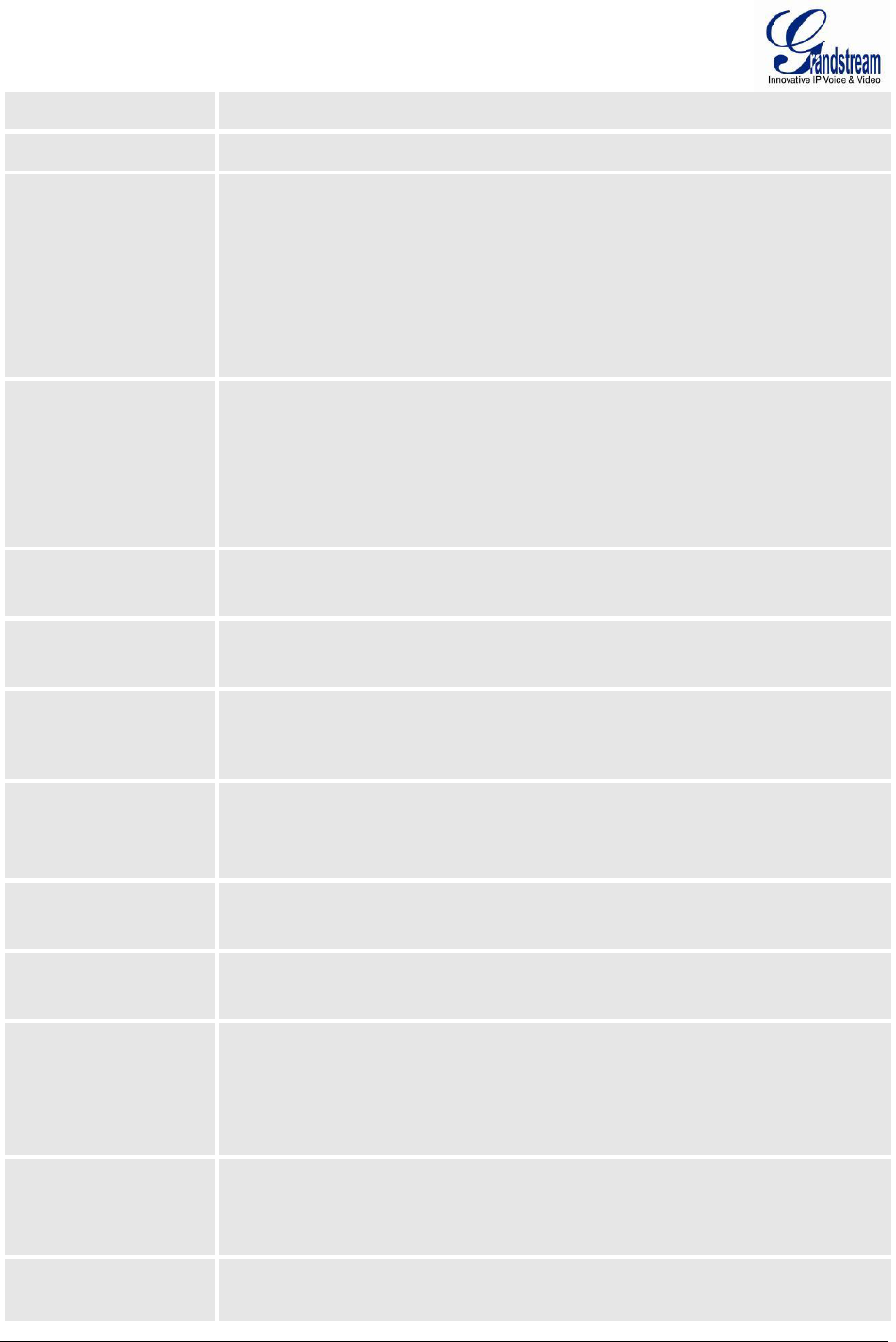
FIRMWARE VERSION 1.0.0.5 HT802 USER MANUAL Page 31 of 46
Authenticate Password
SIP service subscriber’s account password.
Name
SIP service subscriber’s name for Caller ID display.
DNS Mode
One from the 3 modes are available for “DNS Mode” configuration:
-A Record (for resolving IP Address of target according to domain name)
-SRV (DNS SRV resource records indicates how to find services for various protocols)
-NAPTR/SRV (Naming Authority Pointer according to RFC 2915)
One mode can be chosen for the client to look up server.
The default value is “A Record”
Tel URI
The default setting is “Disabled”. If the phone has an assigned PSTN
Number, this field should be set to “User=Phone” then a
“User=Phone” parameter will be attached to the “From header” in the SIP
request to indicate the E.164 number. If server supports TEL URI format, then this
option needs to be selected.
SIP Registration
Controls whether the HT802 needs to send REGISTER messages to the proxy server.
The default setting is Yes.
Unregister on Reboot
Default is No. If set to Yes, the SIP user’s registration information will be cleared on
reboot.
Outgoing Call without
Registration
Default is No. If set to “Yes,” user can place outgoing calls even when not registered (if
allowed by Internet Telephone Service Provider) but is unable to receive incoming
calls.
Register Expiration
This parameter allows the user to specify the time frequency (in minutes) the HT802
refreshes its registration with the specified registrar. The default interval is 60 minutes
(or 1 hour). The maximum interval is 65535 minutes (about 45 days).
SIP Registration Failure
Retry Wait Time
Retry registration if the process failed. Default is 20 seconds.
Local SIP port
Defines the local SIP port the HT802 will listen and transmit. The default value for FXS
port is 5060.
Local RTP port
Defines the local RTP-RTCP port pair the HT802 will listen and transmit. It is the base
RTP port for channel 0. When configured,
channel 0 uses this port _value for RTP and the port_value+1 for its RTCP
The default value for FXS port is 5004.
Use Random SIP Port
Default is No. This parameter forces the random generation of The local SIP ports
when set to Yes. This is usually necessary when multiple HT802 are behind the same
NAT.
Use Random RTP Port
Default is No. This parameter forces the random generation of the local RTP ports
when set to Yes. This is usually necessary when multiple HT802 are behind the same
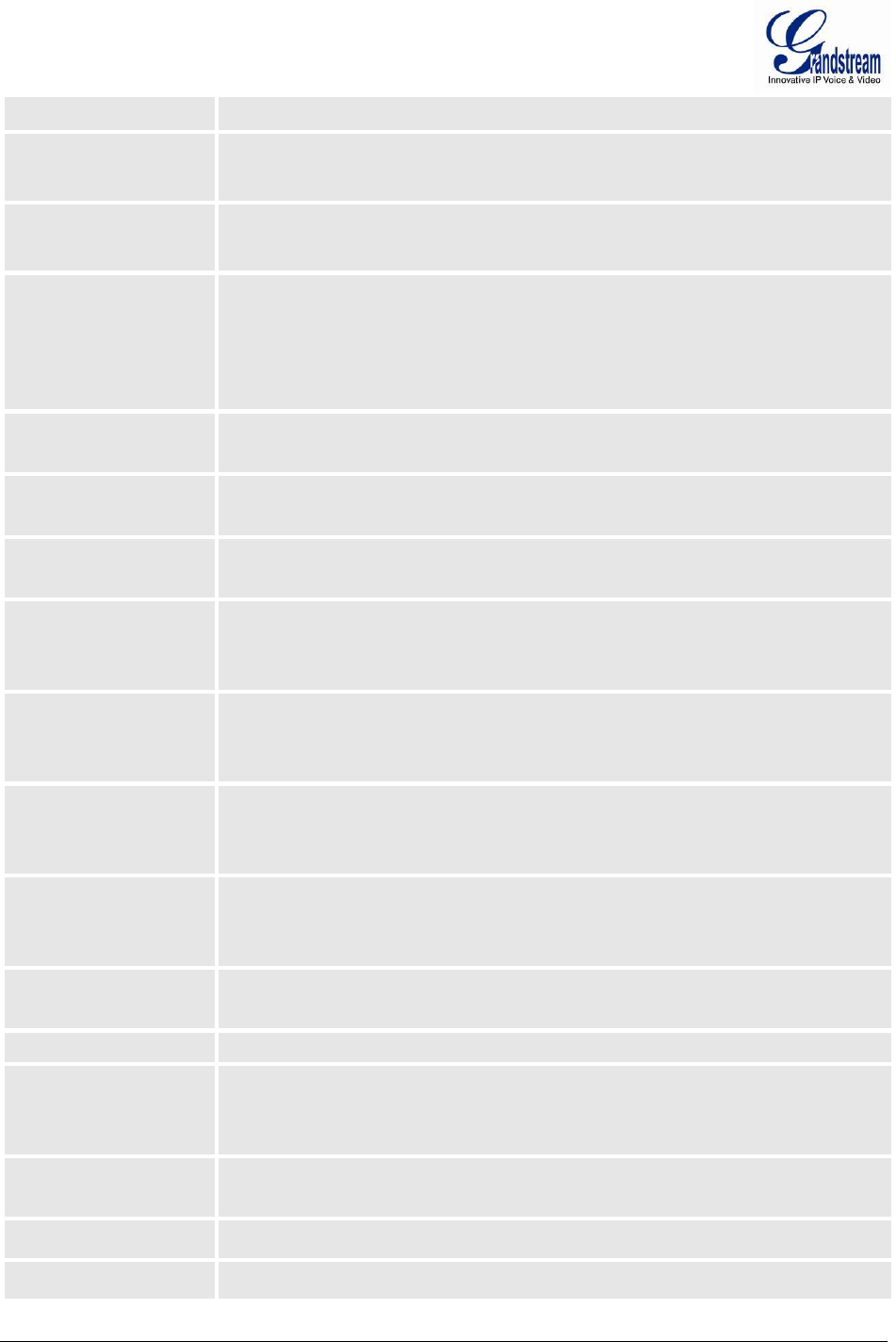
FIRMWARE VERSION 1.0.0.5 HT802 USER MANUAL Page 32 of 46
NAT.
Enable RTCP
Default is Yes. Enable/Disable RTCP to provides out-of-band statistics and control
information for RTP session.
Refer-to Use Target
Contact
Default is No. If set to YES, then for Attended Transfer, the “Refer-To” header uses the
transferred target’s Contact header information.
Transfer on Conference
Hang up
Default is No. In which case if the conference originator hangs up the conference will
be terminated. When option YES is chosen, originator will transfer other parties to
each other so that B and C can choose to either continue the conversation or
hang up.
Disable Bellcore Style
3-Way Conference
Default is No. you can make a Conference by pressing ‘Flash’ key. If set to Yes, you
need to dial *23 + second callee number.
Remove OBP from
Route Header
Default is No. When option YES is chosen, the Out Bound Proxy will be removed from
Route header.
Support SIP Instance ID
Default is Yes. If set to Yes, the contact header in REGISTER request will contain SIP
Instance ID as defined in IETF SIP Outbound draft.
Validate incoming SIP
message
Default is No. If set to yes all incoming SIP messages will be strictly validated
according to RFC rules. If message will not pass validation process, call will be
rejected.
Check SIP User ID for
incoming INVITE
Default is No. Check the incoming SIP User ID in Request URI. If they don’t match, the
call will be rejected. If this option is enabled, the device will not be able to make direct
IP calls.
Allow Incoming SIP
Messages from SIP
Proxy Only
Default is No. Check the incoming SIP messages. If they don’t come from the SIP
proxy, they will be rejected. If this option is enabled, the device will not be able to make
direct IP calls.
SIP T1 Timeout
T1 is an estimate of the round-trip time between the client and server transactions.
If the network latency is high, select larger value for more reliable usage. Default is 0.5
Sec.
SIP T2 Interval
Maximum retransmission interval for non-INVITE requests and INVITE responses.
Default is 4 Sec.
DTMF Payload Type
Sets the payload type for DTMF using RFC2833. Default is 101.
Preferred DTMF method
(in listed order)
The HT802 supports up to 3 different DTMF methods including in-audio, via RTP
(RFC2833) and via Sip Info using SIP INFO messages. The user can configure DTMF
method in a priority list.
Disable DTMF
Negotiation
Default is No. If set to yes, use above DTMF order without negotiation
Send Hook Flash Event
Default is No. If set to yes, flash will be sent as DTMF event.
Enable Call Features
Default is Yes. (If Yes, call features using star codes will be supported locally)
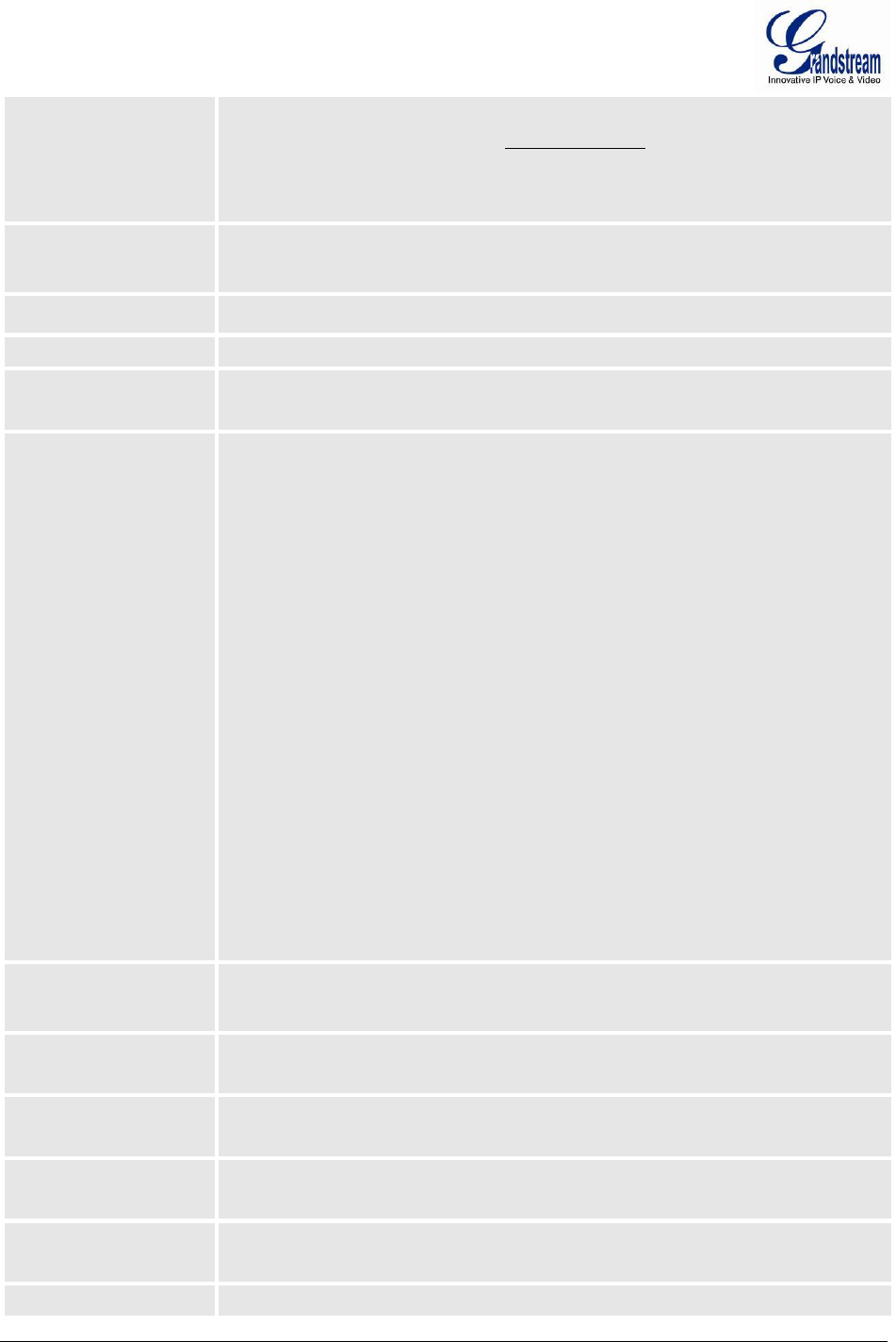
FIRMWARE VERSION 1.0.0.5 HT802 USER MANUAL Page 33 of 46
Offhook Auto-Dial
This parameter allows users to configure a User ID or extension number that is
automatically dialed when off-hook. Only the user part of a SIP address needs to be
entered here. The HT802 will automatically append the “@” and the host portion of the
corresponding SIP address.
Offhook Auto-Dial
Delay
The auto-dial delay after off hook.
Proxy-Require
SIP Extension to notify SIP server that the unit is behind the NAT/Firewall.
Use NAT IP
NAT IP address used in SIP/SDP message. Default is blank.
Use SIP User-Agent
Header
Configurable SIP User-Agent Header.
Distinctive Ring Tone
Custom Ring Tone 1 to 3 with associate Caller ID: when selected, if Caller ID is
configured, then the device will ONLY uses this ring tone when the incoming call is
from the Caller ID. System Ring Tone is used for all other calls. When selected but no
Caller ID is configured, the selected ring tone will be used for all incoming calls using
the FXS port or Profile. Distinctive ring tones can be configured not only for matching a
whole number, but also for matching prefixes. In this case symbol * (star) will be used.
For example:
if configured as *617, Ring Tone 1 will be used in case of call arrived from the area
code 617. Any other incoming call will ring using cadence defined in parameter System
Ring Cadence located under Advanced Settings Configuration page.
Note: If server supports Alert-Info header and standard ring tone set (Bellcore) or
distinctive ring tone 1-10 is specified, then the ring tone in the Alert-Info header from
server will be used. Bellcore rings and tones are independent from custom ring tones.
The custom ring tones can also be specified by alert-info header, for example
Alert-Info: <http://127.0.0.1>;info=ring5
Disable Call-Waiting
Default is No. If set to YES Call Waiting indication information will not be provided to
analog phone connected to this FXS port.
Disable Call-Waiting
Caller ID
Default is No. If set to YES Call Waiting caller ID will not be provided to analog phone
connected to this FXS port.
Disable Call Waiting
Tone
Default is No. This is to disable the stutter Call Waiting Tone when a Call Waiting
information arrives. The CWCID information will still be displayed.
Disable Receiver
Offhook Tone
Default is No. If set to yes, it will disable the warning to alert that the phone has been
left off-hook for an extended period of time.
Disable Reminder Ring
for On-Hold Call
Default is No. Do not play the reminder ring when this is set to Yes.
Disable Visual MWI
Default is No. If set to “Yes”, the MWI information will not be transferred to the analog

FIRMWARE VERSION 1.0.0.5 HT802 USER MANUAL Page 34 of 46
phone connected to the FXS port.
Ring Timeout
Default value is 60 Sec. Incoming call will stop ringing when not picked up given a
specific period of time.
Delayed Call Forward
Wait Time
Default value is 20 seconds. In case this feature activated using * codes (*92 code),
the call will be forwarded after this preconfigured amount of time.
No Key Entry Timeout
Default is 4 seconds. Dialing process is completed and outgoing call is initiated if no
key entry occurs during this preconfigured interval.
Early Dial
Default is No. Use only if proxy supports 484 response. This parameter controls
whether the phone will send an early INVITE each time a key is pressed when a user
dials a number. If set to “Yes”, an INVITE is sent using the dial-number collected thus
far; Otherwise, no INVITE is sent until the “(Re-)Dial” button is pressed or after about 5
seconds have elapsed if the user forgets to press the “Re-Dial” button.
The “Yes” option should be used ONLY if there is a SIP proxy configured and the proxy
server supports 484 Incomplete Address response. Otherwise, the call will likely be
rejected by the proxy (with a 404 Not Found error).
This feature does NOT work with and should NOT be enabled for direct IP-to-IP calling.
Dial Plan Prefix
Sets the prefix added to each dialed number.
Use # as Dial Key
Default is Yes. It allows users to configure the “#” key as the “Send” (or “Dial”) key. If
set to “Yes”, “#” will send the number. In this case, this key is essentially equivalent to
the “Dial” key. If set to “No”, this “#” key can be included as part of number.
Dial Plan
Dial Plan Rules:
1. Accept Digits: 1,2,3,4,5,6,7,8,9,0 , *, #, A,a,B,b,C,c,D,d
2. Grammar: x - any digit from 0-9;
xx+ - at least 2 digits number;
xx. – at least 2 digit number.
^ - exclude;
[3-5] - any digit of 3, 4, or 5;
[147] - any digit 1, 4, or 7;
<2=011> - replace digit 2 with 011 when dialing
< =1> - add a leading 1 to all numbers dialed, vice versa will remove
a 1 from the number dialed
| - or
• Example 1: {[369]11 | 1617xxxxxxx} – Allow 311, 611, 911, and any 11 digit
numbers with leading digits 1617
Example 2: {^1900x+ | <=1617>xxxxxxx} – Block any number of leading digits

FIRMWARE VERSION 1.0.0.5 HT802 USER MANUAL Page 35 of 46
1900 and add prefix 1617 for any dialed 7 digit numbers
• Example 3: {1xxx[2-9]xxxxxx | <2=011>x+} –Allow any combinations of numbers
with 11 digits which has a leading digit 1, but 5th digit cannot be 0 or 1. Or any length
of numbers with a minimum of 2 digits beginning with 2, with the leading digit
replaced with 011.
3. Default: Outgoing - {x+}
Example of a simple dial plan used in a Home/Office in the US:
{ ^1900x. | <=1617>[2-9]xxxxxx | 1[2-9]xx[2-9]xxxxxx | 011[2-9]x. | [3469]11 }
Explanation of example rule (reading from left to right):
• ^1900x. - prevents dialing any number started with 1900
• <=1617>[2-9]xxxxxx - allows dialing to local area code (617) numbers by dialing
7 numbers and 1617 area code will be added automatically
• 1[2-9]xx[2-9]xxxxxx |- allows dialing to any US/Canada Number with 11 digits
length
• 011[2-9]x. - allows international calls starting with 011
• [3469]11 - allow dialing special and emergency numbers 311, 411, 611 and 911
Note: In some cases user wishes to dial strings such as *123 to activate voice mail or
other application provided by service provider. In this case * should be predefined
inside dial plan feature and the Dial Plan should be: { *x+ }.
Subscribe for MWI
Default is No. When set to “Yes” a SUBSCRIBE for Message Waiting Indication will be
sent periodically.
Send Anonymous
Default is No. If this parameter is set to “Yes”, the “From” header along with Privacy
and P_ Asserted_Identity headers in outgoing INVITE message will be set to
anonymous, blocking Caller ID.
Anonymous Call
Rejection
Default is No. If set to Yes, incoming calls with anonymous Caller ID will be rejected
with 486 Busy message.
Special Feature
Default is Standard. Choose the selection to meet some special requirements from
Softswitch vendors.
Session Expiration
Grandstream implemented SIP Session Timer. The session timer extension enables
SIP sessions to be periodically “refreshed” via a SIP request (UPDATE, or re-INVITE.
Once the session interval expires, if there is no refresh via a UPDATE or re-INVITE
message, the session will be terminated. Session Expiration is the time (in seconds) at
which the session is considered timed out, if no successful session refresh transaction
occurs beforehand. The default value is 180 seconds.
Min-SE
The minimum session expiration (in seconds). The default value is 90 seconds.
Caller Request Timer
Default is No. If selecting “Yes” the phone will use session timer when it makes
outbound calls if remote party supports session timer.
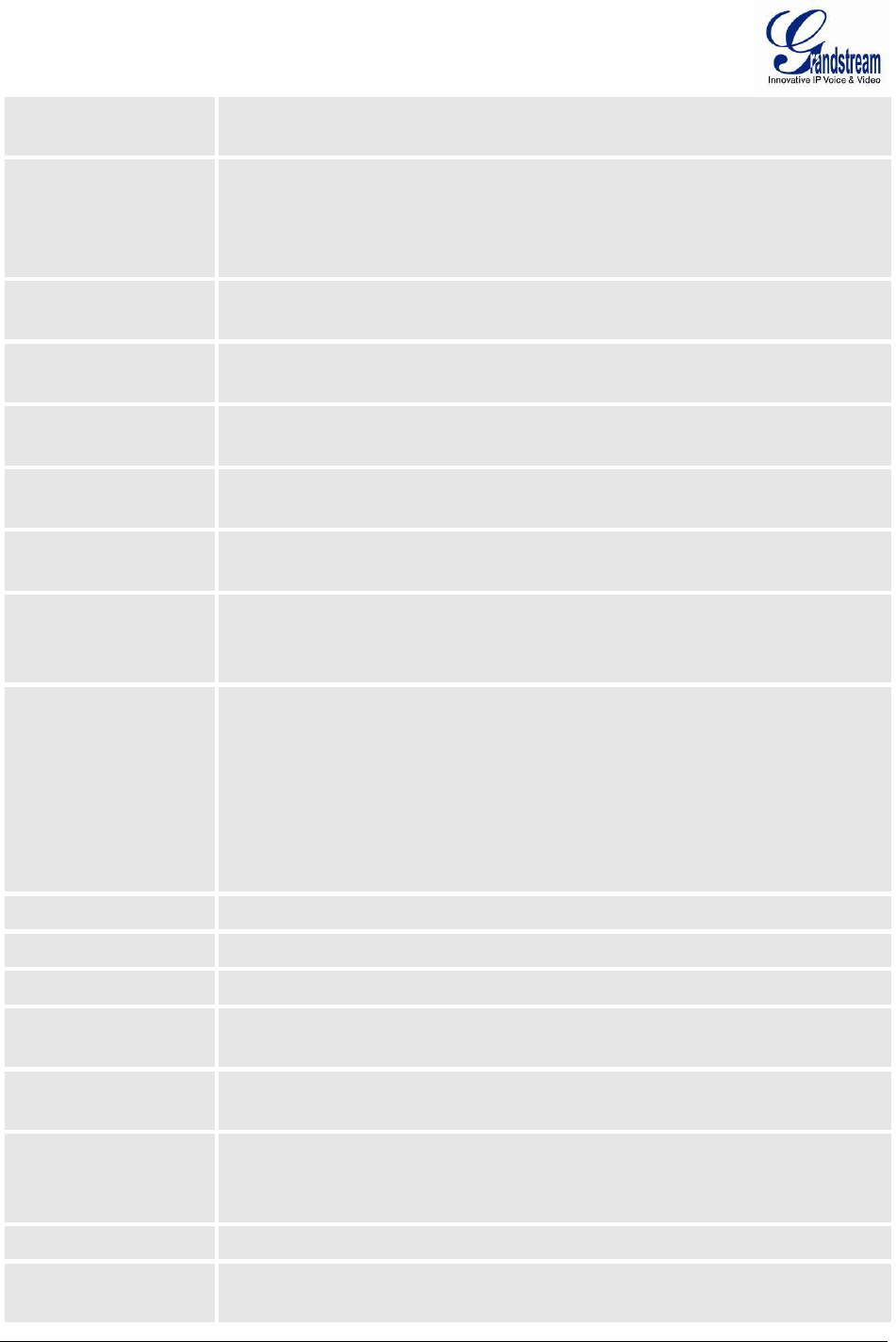
FIRMWARE VERSION 1.0.0.5 HT802 USER MANUAL Page 36 of 46
Callee Request Timer
Default is No. If selecting “Yes” the phone will use session timer when it receives
inbound calls with session timer request.
Force Timer
Default is No. If selecting “Yes” the phone will use session timer even if the remote
party does not support this feature. Selecting “No” will allow the phone to enable
session timer only when the remote party support this feature. To turn off Session
Timer, select “No” for Caller Request Timer, Callee Request Timer, and Force Timer.
UAC Specify Refresher
Default is Omit. As a Caller, select UAC to use the phone as the refresher, or UAS to
use the Callee or proxy server as the refresher.
UAS Specify Refresher
Default is UAC. As a Callee, select UAC to use caller or proxy server as the refresher,
or UAS to use the phone as the refresher.
Force INVITE
Session Timer can be refreshed using INVITE method or UPDATE method. Select
“Yes” to use INVITE method to refresh the session timer. Default is No,
Send Re-INVITE After
Fax
Default is No, If set to “Yes”, device will send an INVITE with audio vocoders upon
completion of Fax to continue session in audio only.
Enable 100rel
Default is No, If set to Yes, Enables the use of PRACK (Provisional Acknowledgment)
method.
Use First Matching
Vocoder in 200OK SDP
Default is No. If set to “Yes”, device will include only the first match vocoder in its
200OK response, otherwise it will include all match vocoders in same order received in
INVITE.
Preferred Vocoder
(in listed order)
The HT802 supports up to 5 different Vocoder types including G.711 A-/U-law, G.726-
32, G.723.1, G.729A/B/E, iLBC. The user can configure Vocoders in a preference list
that will be included with the same preference order in SDP message. The first
Vocoder is entered by choosing the appropriate option in “Choice 1”. The last Vocoder
is entered by choosing the appropriate option in “Choice 6”.
Vocoder types can also be changed per call basis by using a star code. Please see the
“Call features” section.
Voice Frames per TX
Default is 2. Defines the number of voice frames sent in each packet.
G723 Rate
Default is 6.3kbps. Defines the encoding rate for G.723.1 vocoder.
iLBC Frame Size
Default is 20ms. Sets the iLBC frame size in 20ms or 30ms.
iLBC Payload type
Defines payload type for iLBC. Default value is 97. The valid range is between 96 and
127.
VAD
Default is No. VAD allows detecting the absence of audio and conserve bandwidth by
preventing the transmission of "silent packets" over the network.
Symmetric RTP
Default is No. When set to Yes the device will change the destination to send RTP
packets to the source IP address and port of the inbound RTP packet last received by
the device.
Fax Mode
T.38 (Auto Detect) FoIP by default, or Pass-Through (must use codec PCMU/PCMA)
Re-Invite after Fax Tone
Detection Mode
Default is Enabled. It makes the unit send out the re-INVITE for T.38 or Fax Pass
Through if a fax tone is detected.
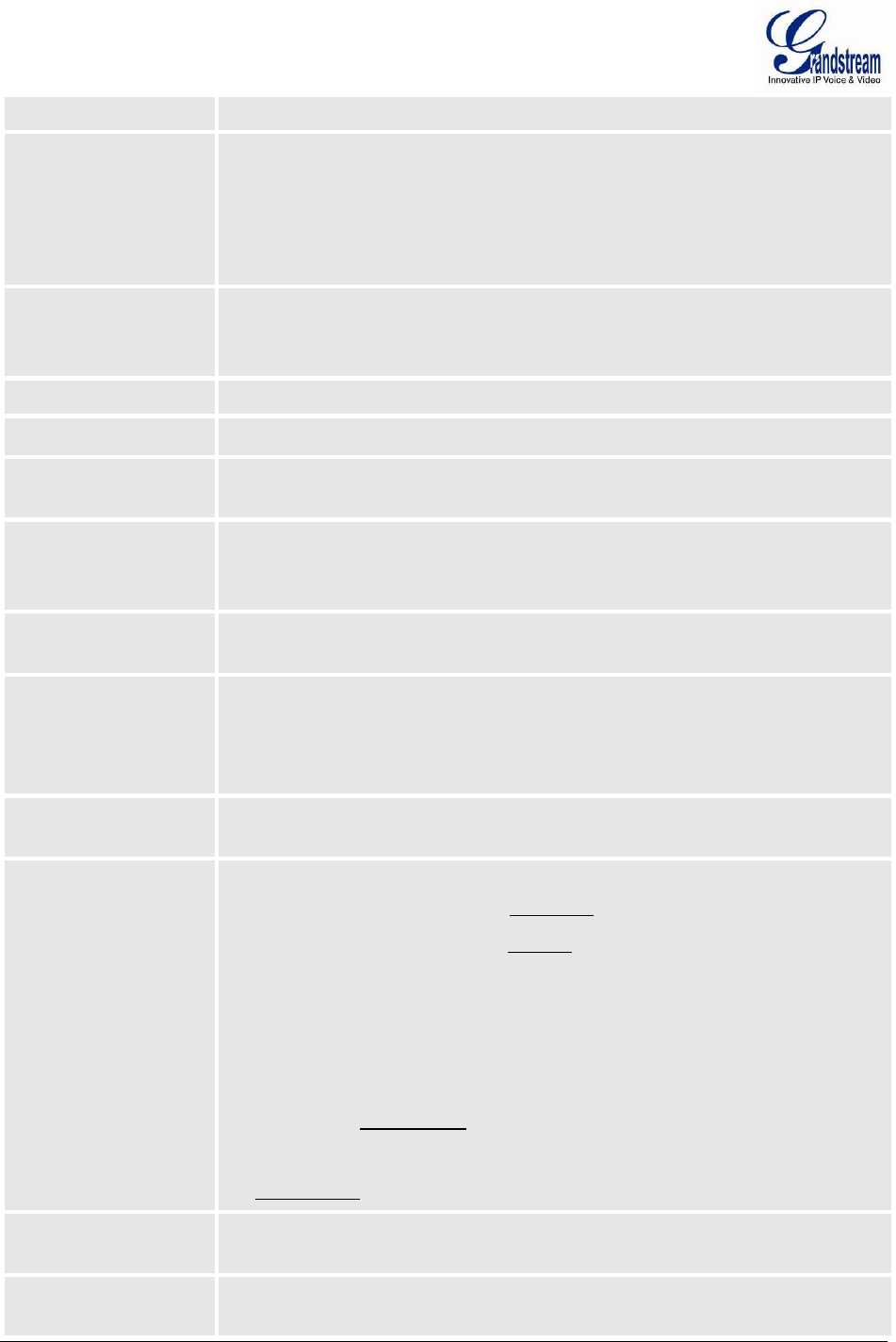
FIRMWARE VERSION 1.0.0.5 HT802 USER MANUAL Page 37 of 46
Jitter Buffer Type
Select either Fixed or Adaptive based on network conditions. Default is Adaptive.
Jitter Buffer Length
Select Low, Medium or High based on network conditions. Default is Medium.
High (initial 200ms, min 40ms, max 600ms) Note: not all vocoders can meet
the high requirement
Medium (initial 100ms, min 20ms, max 200ms)
Low (initial 50ms, min 10ms, max 100ms)
SRTP Mode
This option defines different implementation of support SRTP (squired RTP)
transmission mode. Select between Disabled, Enabled but not Forced, and Enabled
and Forced. Default is Disabled.
SLIC Setting
Dependent on standard phone type (and location)
Caller ID Scheme
Bellcore/Telcordia, ETSI-FSK, ETSI-DTMF, SIN 227 – BT, & NTT Japan, Brazil
Polarity Reversal
Default is No. If set to “Yes”, polarity will be reversed upon call establishment and
termination.
Loop Current
Disconnect
Default is No. Set it to Yes if the traditional PBX you are using with HT802 uses this
method for signaling call termination. Method initiates short voltage drop on the line
when remote (VoIP) side disconnects an active call.
Loop Current
Disconnect Duration
Default value is 200. Here can be configured duration of such voltage drop described in
topic above. HT802 supports a Duration Range from 100 to 10000 ms.
Hook Flash Timing
Time period when the cradle is pressed (Hook Flash) to simulate FLASH. To prevent
unwanted activation of the Flash/Hold and automatic phone ring-back, adjust this time
value. Default values are 300 minimum and 1100 maximum. HT802 supports a
range from 40 to 2000 ms.
On Hook Timing
On-hook timing is the minimum time for an on-hook event to be validated. Default
value is 400 . HT802 supports a range from 40 to 2000 ms.
Gain
Voice path volume adjustment.
• Rx is a gain level for signals transmitted by FXS
• Tx is a gain level for signals received by FXS.
Default = 0dB for both parameters. Loudest volume: +6dB Lowest volume: -6dB.
User can adjust volume of call on either end using the Rx Gain Level parameter and
the Tx Gain Level parameter located on the FXS Port Configuration page.
If call volume is too low when using the FXS port (ie. the ATA is at user site), adjust
volume using the Rx Gain Level parameter under the FXS Port Configuration page.
If voice volume is too low at the other end, user may increase the far end volume using
the Tx Gain Level parameter under the FXS Port Configuration page.
Disable Line Echo
Canceller (LEC)
Default is No. If set to “Yes” LEC will be disabled per call base. Recommended for
FAX/Data calls.
Outgoing Call Duration
Limit
Default is 0. When set to 0. There will be no limit. Time range (0-180 minutes).

FIRMWARE VERSION 1.0.0.5 HT802 USER MANUAL Page 38 of 46
Ring Tones
This function lets you configure ring tone cadence preferences. User has 10 choices.
The configuration, completed in Distinctive Ring Tones block in the same page, applies
to ring tones cadences configured here.
SAVING THE CONFIGURATION CHANGES
Click the “Update” button in the Configuration page to save the changes to the HT802 configuration. The
following screen confirms that the changes are saved. Reboot or power cycle the HT802 to make the
changes take effect.
REBOOTING THE HT802 FROM REMOTE
Press the “Reboot” button at the bottom of the configuration menu to reboot the ATA remotely. The web
browser will then display a message window to confirm that reboot is underway. Wait 30 seconds to log in
again.

FIRMWARE VERSION 1.0.0.5 HT802 USER MANUAL Page 39 of 46
SOFTWARE UPGRADE
Software upgrade can be done via either TFTP or HTTP. The corresponding configuration settings are in
the ADVANCED SETTINGS configuration page.
FIRMWARE UPGRADE THROUGH TFTP/HTTP/HTTPS
To upgrade via TFTP or HTTP/HTTPS, the “Firmware Upgrade and Provisioning upgrade via” field needs
to be set to TFTP HTTP or HTTPS, respectively. “Firmware Server Path” needs to be set to a valid URL
of a TFTP or HTTP server, server name can be in either FQDN or IP address format. Here are examples
of some valid URL.
e.g. firmware.mycompany.com:6688/Grandstream/1.0.5.2
e.g. firmware.grandstream.com
NOTES:
Firmware upgrade server in IP address format can be configured via IVR. Please refer to the
CONFIGURATION GUIDE section for instructions. If the server is in FQDN format, it must be set
via the web configuration interface.
Grandstream recommends end-user use the Grandstream HTTP server. Its address can be
found at http://www.grandstream.com/support/firmware . Currently the HTTP firmware server IP
address is firmware.grandstream.com. For large companies, we recommend to maintain their
own TFTP/ HTTP/HTTPS server for upgrade and provisioning procedures.
Once a “Firmware Server Path” is set, user needs to update the settings and reboot the device. If
the configured firmware server is found and a new code image is available, the HT802 will
attempt to retrieve the new image files by downloading them into the HT802’s SRAM. During this
stage, the HT802’s LEDs will blink until the checking/downloading process is completed. Upon
verification of checksum, the new code image will then be saved into the Flash. If
TFTP/HTTP/HTTPS fails for any reason (e.g. TFTP/HTTP/HTTPS server is not responding, there
are no code image files available for upgrade, or checksum test fails, etc), the HT802 will stop the
TFTP/HTTP/HTTPS process and simply boot using the existing code image in the flash.
Firmware upgrade may take as long as 15 to 30 minutes over Internet, or just 5 minutes if it is
performed on a LAN. It is recommended to conduct firmware upgrade in a controlled LAN
environment if possible. For users who do not have a local firmware upgrade server,
Grandstream provides a NAT-friendly TFTP server on the public Internet for firmware upgrade.

FIRMWARE VERSION 1.0.0.5 HT802 USER MANUAL Page 40 of 46
Grandstream’s latest firmware is available at http://www.grandstream.com/support/firmware .
Oversea users are strongly recommended to download the binary files and upgrade firmware
locally in a controlled LAN environment.
Note: Alternatively, the user can upload the firmware single file from his/her computer using a local
directory. For more instructions see below. Also the user can download a free TFTP or HTTP server and
conduct local firmware upgrade. A free windows version TFTP server is available for download from
http://support.solarwinds.net/updates/New-customerFree.cfm. Our latest official release can be
downloaded from http://www.grandstream.com/support/firmware .
INSTRUCTIONS FOR UPLOAD FROM LOCAL DIRECTORY:
1- Download the firmware file from Grandstream web site
2- Unzip it and copy the file in to a folder in your PC
3- From the HT802 web interface (Advanced Settings page) you can browse your hard drive and
select the folder you previously saved the file (HT802fw.bin)
4- Click “Upload Firmware” and wait few minutes until the new program is loaded.
Note: Always check the status page to see that the program version has changed.
INSTRUCTIONS FOR LOCAL FIRMWARE UPGRADE USING TFTP SERVER:
1. Unzip the file and put all of them under the root directory of the TFTP server.
2. Put the PC running the TFTP server and the HT802 device in the same LAN segment.
3. Please go to File -> Configure -> Security to change the TFTP server's default setting from
"Receive Only" to "Transmit Only" for the firmware upgrade.
4. Start the TFTP server, in the phone’s web configuration page
5. Configure the Firmware Server Path with the IP address of the PC
6. Update the change and reboot the unit
End users can also choose to download the free HTTP server from http://httpd.apache.org/ or use
Microsoft IIS web server.
CONFIGURATION FILE DOWNLOAD
Grandstream SIP Device can be configured via Web Interface as well as via Configuration File through
TFTP or HTTP/HTTPS. “Config Server Path” is the TFTP or HTTP/HTTPS server path for configuration

FIRMWARE VERSION 1.0.0.5 HT802 USER MANUAL Page 41 of 46
file. It needs to be set to a valid URL, either in FQDN or IP address format. The “Config Server Path” can
be same or different from the “Firmware Server Path”.
A configuration parameter is associated with each particular field in the web configuration page. A
parameter consists of a Capital letter P and 1 to 3 (Could be extended to 4 in the future) digit numeric
numbers. i.e., P2 is associated with “Admin Password” in the ADVANCED SETTINGS page. For a
detailed parameter list, please refer to the corresponding firmware release configuration template.
When a Grandstream device boots up or reboots, it will issue a request for a configuration file
“cfgxxxxxxxxxxxx”, where “xxxxxxxxxxxx” is the MAC address of the device, i.e., “cfg000b820102ab”. In
addition, device will also requests a XML configuration file “cfgxxxxxxxxxxxx.xml”. If the download of
“cfgxxxxxxxxxxxx.xml” is not successful, the provision program will issue a request for a generic
conf ig ur at io n fi le “c fg.x ml” . C onfi guration f ile nam e should b e in lo wer case le tt ers.
For more details on XML provisioning, please refer to:
http://www.grandstream.com/general/gs_provisioning_guide_public.pdf
FIRMWARE AND CONFIGURATION FILE PREFIX AND POSTFIX
Firmware Prefix and Postfix allows device to download the firmware name with the matching Prefix and
Postfix. This makes it the possible to store ALL of the firmware with different version in one single
directory. Similarly, Config File Prefix and Postfix allows device to download the configuration file with the
matching Prefix and Postfix. Thus multiple configuration files for the same device can be stored in one
directory.
In addition, when the field “Check New Firmware only when F/W pre/suffix changes” is set to “Yes”, the
device will only issue firmware upgrade request if there are changes in the firmware Prefix or Postfix.
MANAGING FIRMWARE AND CONFIGURATION FILE DOWNLOAD
When “Automatic Upgrade” is set “Yes, every” the auto check will be done in the minute specified in this
field. If set to “daily at hour (0-23)”, Service Provider can use P193 (Auto Check Interval) to have the
devices do a daily check at the hour set in this field with either Firmware Server or Config Server. If set to
“weekly on day (0-6)” the auto check will be done in the day specified in this field. This allows the device
periodically check if there are any new changes need to be taken on a scheduled time. By defining
different intervals in P193 for different devices, Server Provider can spread the Firmware or Configuration
File download in minutes to reduce the Firmware or Provisioning Server load at any given time.

FIRMWARE VERSION 1.0.0.5 HT802 USER MANUAL Page 42 of 46
Automatic Upgrade:
No Yes, every minutes(60-5256000).
Yes, daily at hour (0-23). Yes, weekly on day (0-6).

FIRMWARE VERSION 1.0.0.5 HT802 USER MANUAL Page 43 of 46
RESTORE FACTORY DEFAULT SETTING
WARNING! Restoring the Factory Default Setting will DELETE all configuration information of the phone.
Please BACKUP or PRINT out all the settings before you approach to following steps. Grandstream will
not take any responsibility if you lose all the parameters of setting and cannot connect to your VoIP
service provider.
FACTORY RESET
There are three (3) methods for resetting your unit:
RESET BUTTON
Reset default factory settings following these four (4) steps:
1. Unplug the Ethernet cable.
2. Locate a needle-sized hole on the back panel of the gateway unit next to the power
connection.
3. Insert a pin in this hole, and press for about 7 seconds.
4. Take out the pin. All unit settings are restored to factory settings.
IVR COMMAND
Reset default factory settings using the IVR Prompt (Table 5):
1. Dial “***” for voice prompt.
2. Enter “99” and wait for “reset” voice prompt.
3. Enter the encoded MAC address (Look below on how to encode MAC address).
4. Wait 15 seconds and device will automatically reboot and restore factory settings.
Encode the MAC Address
1. Locate the MAC address of the device. It is the 12 digit HEX number on the bottom of the
unit.
2. Key in the MAC address. Use the following mapping:
0-9: 0-9
A: 22 (press the “2” key twice, “A” will show on the LCD)
B: 222

FIRMWARE VERSION 1.0.0.5 HT802 USER MANUAL Page 44 of 46
C: 2222
D: 33 (press the “3” key twice, “D” will show on the LCD)
E: 333
F: 3333
For example: if the MAC address is 000b8200e395, it should be keyed in as “0002228200333395”.
RESET FROM WEB INTERFACE (RESET TYPE)
1. From the Advanced Settings Page user can select three types:
Full Reset: This will make a full reset
ISP Data: This will reset only the basic settings, like IP mode, PPPoE and Web port
VOIP Data: This will reset only the data related with a service provider like SIP server, sip
user ID, provisioning and others.
NOTE:
1. Factory Reset will be disabled if the “Lock keypad update” is set to “Yes”.
2. If the HT802 was previously locked by your local service provider, pressing the RESET button will
only restart the unit. The device will not return to factory default settings.

FIRMWARE VERSION 1.0.0.5 HT802 USER MANUAL Page 45 of 46
FCC Compliance Statement:
This device complies with part 15 of the FCC Rules. Operation is subject to the following two
conditions:(1)This device may not cause harmful interference, and (2) this device must accept any
interference received, including interference that may cause undesired operation.
Important: Any Changes or modifications not expressly approved by the party responsible for compliance
could void the user's authority to operate the equipment.
Note: This equipment has been tested and found to comply with the limits for a Class B digital device,
pursuant to part 15 of the FCC Rules.
These limits are designed to provide reasonable protection against harmful interference in a residential
installation. This equipment generates, uses and can radiate radio frequency energy and, if not installed
and used in accordance with the instructions, may cause harmful interference to radio communications.
However, there is no guarantee that interference will not occur in a particular installation.
If this equipment does cause harmful interference to radio or television reception, which can be
determined by turning the equipment off and on, the user is encouraged to try to correct the interference
by one or more of the following measures:
—Reorient or relocate the receiving antenna.
—Increase the separation between the equipment and receiver.
—Connect the equipment into an outlet on a circuit different from that to which the receiver is connected.
—Consult the dealer or an experienced radio/TV technician for help.